Material characteristic
面向静态体压分布和垂向振动响应的坐姿人体模型建模
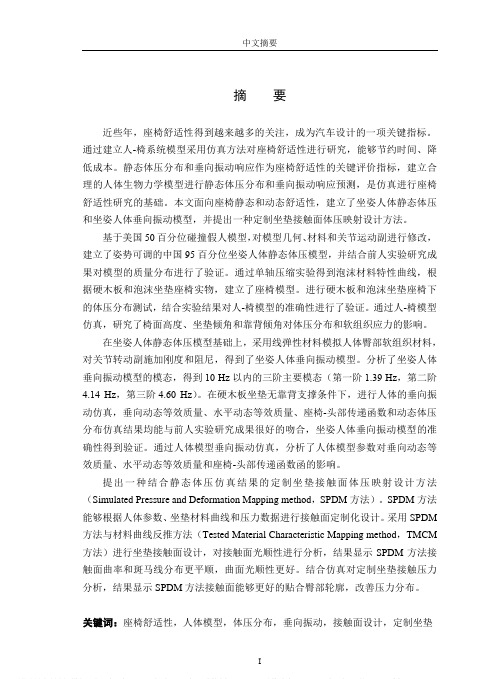
摘要近些年,座椅舒适性得到越来越多的关注,成为汽车设计的一项关键指标。
通过建立人-椅系统模型采用仿真方法对座椅舒适性进行研究,能够节约时间、降低成本。
静态体压分布和垂向振动响应作为座椅舒适性的关键评价指标,建立合理的人体生物力学模型进行静态体压分布和垂向振动响应预测,是仿真进行座椅舒适性研究的基础。
本文面向座椅静态和动态舒适性,建立了坐姿人体静态体压和坐姿人体垂向振动模型,并提出一种定制坐垫接触面体压映射设计方法。
基于美国50百分位碰撞假人模型,对模型几何、材料和关节运动副进行修改,建立了姿势可调的中国95百分位坐姿人体静态体压模型,并结合前人实验研究成果对模型的质量分布进行了验证。
通过单轴压缩实验得到泡沫材料特性曲线,根据硬木板和泡沫坐垫座椅实物,建立了座椅模型。
进行硬木板和泡沫坐垫座椅下的体压分布测试,结合实验结果对人-椅模型的准确性进行了验证。
通过人-椅模型仿真,研究了椅面高度、坐垫倾角和靠背倾角对体压分布和软组织应力的影响。
在坐姿人体静态体压模型基础上,采用线弹性材料模拟人体臀部软组织材料,对关节转动副施加刚度和阻尼,得到了坐姿人体垂向振动模型。
分析了坐姿人体垂向振动模型的模态,得到10 Hz以内的三阶主要模态(第一阶1.39 Hz,第二阶4.14 Hz,第三阶4.60 Hz)。
在硬木板坐垫无靠背支撑条件下,进行人体的垂向振动仿真,垂向动态等效质量、水平动态等效质量、座椅-头部传递函数和动态体压分布仿真结果均能与前人实验研究成果很好的吻合,坐姿人体垂向振动模型的准确性得到验证。
通过人体模型垂向振动仿真,分析了人体模型参数对垂向动态等效质量、水平动态等效质量和座椅-头部传递函数函的影响。
提出一种结合静态体压仿真结果的定制坐垫接触面体压映射设计方法(Simulated Pressure and Deformation Mapping method,SPDM方法)。
SPDM方法能够根据人体参数、坐垫材料曲线和压力数据进行接触面定制化设计。
可配置物料bom

下面谈谈配置BOM的一点理解:1.在SAP系统中BOM和VC是两大块知识,当业务需要时把两块知识结合在一起搭建的BOM 称为“变式BOM”;2.当你的产品销售模式主要以客户定制为主,而且产品同一属性可供客户选择的项目比较多,那么从方便客户定制、减少物料编码、BOM数量等综合考虑请启用变式BOM;3.变式BOM的维护相对复杂,额外多出一些类、特性、特性值、配置参数文件、相关性等基础数据维护工作;4.同时由于启用变式BOM,你的其他模块的相应业务可能也要跟使用普通BOM有所不同。
打个比方,有个可配置物料,可配置物料有一个所谓的super bom,穷举所有可能的组件,每个组件有不同的object dependancy,销售订单的不同配置信息就通过object dependancy去抓取定可配置物料所需要的有关组件及其数量。
如果一个非可配置物料恰好对应于可配置物料项下的其中一个配置,那么我们会使用CU41,将这个不可配置物料与super bom完成assignment;不止BOM,super routing 也会指派给这个不可配置物料。
如此,不可配置物料就可以创建工单且能够产生下级组件的需求。
1)可配置物料只有一个号码,它本身有characteristics/class/objectdependancy/configuration profile之类的东西(如果没有configuration profile,销售订单是不能创建的);2)可配置物料是不能CO01手工创建生产工单的,但如果出现了“几种常用配置的产品需要预投库存生产”的场景怎么办?创建一个非可配置物料,MRP3中作指定配置与可配置物料挂钩,CS40与super bom挂钩,ca02与super routing完成material assignment。
这样就可以对“代表常用配置的物料号”(SAP称之为material variant)进行预投生产了。
新课程标准下的小学音乐教材比较研究——以人音版、人教版、辽海版为例
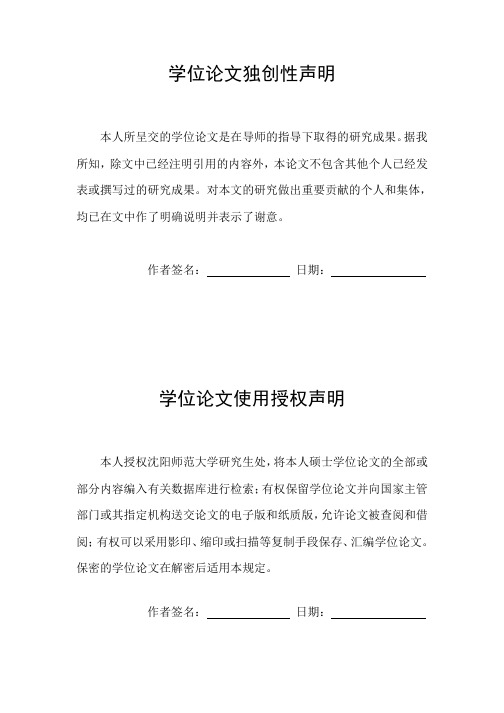
学位论文独创性声明本人所呈交的学位论文是在导师的指导下取得的研究成果。
据我所知,除文中已经注明引用的内容外,本论文不包含其他个人已经发表或撰写过的研究成果。
对本文的研究做出重要贡献的个人和集体,均已在文中作了明确说明并表示了谢意。
作者签名:日期:学位论文使用授权声明本人授权沈阳师范大学研究生处,将本人硕士学位论文的全部或部分内容编入有关数据库进行检索;有权保留学位论文并向国家主管部门或其指定机构送交论文的电子版和纸质版,允许论文被查阅和借阅;有权可以采用影印、缩印或扫描等复制手段保存、汇编学位论文。
保密的学位论文在解密后适用本规定。
作者签名:日期:新课程标准下的小学音乐教材比较研究——以人音版、人教版、辽海版为例中文摘要艺术教育作为培养人们审美能力以及创新思维能力的重要途径,受到了越来越多的重视与关注。
音乐教育的发展离不开国家对音乐学科所制定的音乐课程标准,音乐课程标准把握着国家音乐学科的发展方向,音乐学科的教育教学也随着义务教育的发展而不断提升着,音乐教材成为了不断完善音乐学科教育教学的一个重要的组成部分,音乐教材承载着音乐教育教学的方针与标准,同时也指导着音乐教师的教育教学。
音乐教材的编写需要有审美性、人文性以及道德教育的潜在意义,本文通过分析和比较研究新课程标准下的三版音乐教材,论述教材的革新与优势。
在对音乐教材的深入挖掘的同时也将会对音乐教材的编写起到促进与有效的回馈作用。
本文选用新音乐课程标准下2012-2014年审定出版的辽海版、人音版、人教版小学音乐教材为例,试图运用文献研究法、分析研究法、比较研究法、访谈法等教育科学研究方法,从三个方面进行分析研究:第一章引言,分析了国内外研究现状以及论文写作的目的。
第二章以及第三章,分别从教材的研究概况、三个版本教材系统性的比较分析,第四章总结每个版本教材的特色以及共性特征。
第五章,从教材的本体出发以及教材优势的比较,对前文比较研究的思考,以及对教材建设的设想,从而得出结论。
moldflow_分析报告
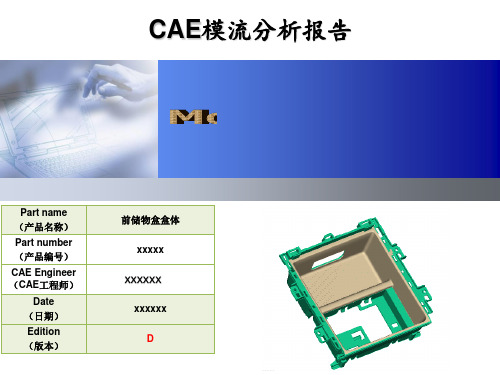
2022/1/12
Pressure at injection location:XY plot
第一射
第二射
Page - 16
injection pressure are acceptable. 注塑压力是可以接受的.
2022/1/12
Clamp force:XY plot(锁模力曲线)
Page - 17
2022/1/12 1/12/2022
Material Data(材料信息) 第二射
TPV Elastron V Grade V250.A64.B:Generic Default
01. 熔融密度
0.82366
g/cm^3
02. 固体密度
0.95654
g/cm^3
03. 建议模温 04. 建议料温
35
Press Shift+F5 to play the fill time animation,Flow behavior are umbalance, has short shot occur. (按shift+F5可播放动画,产品流动不平衡,没有短射发生)
2022/1/12
Fill time(充填时间)
50
℃
10. 最小料溫
210
℃
11. 最大料溫
05. 裂解温度
290
℃
12. 最大剪切力
06. 顶出温度
119
℃
13. 最大剪切率
07.粘度指数
VI(209)0089
14.熔体流动速率
PVT曲线图
40 60 190 230 0.25 100000
11.4
粘度曲线图
Page - 3
(完整版)材料科学与工程专业英语第三版-翻译以及问题详解
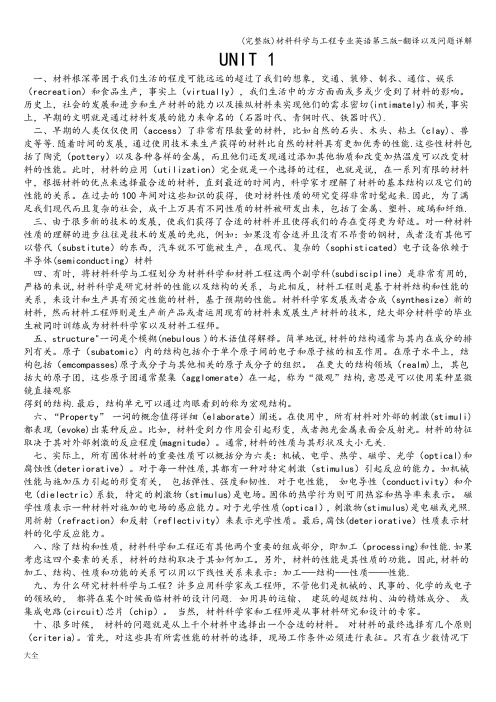
UNIT 1一、材料根深蒂固于我们生活的程度可能远远的超过了我们的想象,交通、装修、制衣、通信、娱乐(recreation)和食品生产,事实上(virtually),我们生活中的方方面面或多或少受到了材料的影响。
历史上,社会的发展和进步和生产材料的能力以及操纵材料来实现他们的需求密切(intimately)相关,事实上,早期的文明就是通过材料发展的能力来命名的(石器时代、青铜时代、铁器时代).二、早期的人类仅仅使用(access)了非常有限数量的材料,比如自然的石头、木头、粘土(clay)、兽皮等等.随着时间的发展,通过使用技术来生产获得的材料比自然的材料具有更加优秀的性能.这些性材料包括了陶瓷(pottery)以及各种各样的金属,而且他们还发现通过添加其他物质和改变加热温度可以改变材料的性能。
此时,材料的应用(utilization)完全就是一个选择的过程,也就是说,在一系列有限的材料中,根据材料的优点来选择最合适的材料,直到最近的时间内,科学家才理解了材料的基本结构以及它们的性能的关系。
在过去的100年间对这些知识的获得,使对材料性质的研究变得非常时髦起来.因此,为了满足我们现代而且复杂的社会,成千上万具有不同性质的材料被研发出来,包括了金属、塑料、玻璃和纤维.三、由于很多新的技术的发展,使我们获得了合适的材料并且使得我们的存在变得更为舒适。
对一种材料性质的理解的进步往往是技术的发展的先兆,例如:如果没有合适并且没有不昂贵的钢材,或者没有其他可以替代(substitute)的东西,汽车就不可能被生产,在现代、复杂的(sophisticated)电子设备依赖于半导体(semiconducting)材料四、有时,将材料科学与工程划分为材料科学和材料工程这两个副学科(subdiscipline)是非常有用的,严格的来说,材料科学是研究材料的性能以及结构的关系,与此相反,材料工程则是基于材料结构和性能的关系,来设计和生产具有预定性能的材料,基于预期的性能。
材料科学与工程专业英语翻译

Unit1:交叉学科interdiscipline介电常数dielectric constant 固体性质solid materials热容heat capacity 力学性质mechanical property电磁辐射electro-magnetic radiation 材料加工processing of materials 弹性模量(模数)elastic coefficient1.直到最近,科学家才终于了解材料的结构要素与其特性之间的关系。
It was not until relatively recent times that scientists came to understand the relationship between the structural elements of materials and their properties .2.材料工程学主要解决材料的制造问题和材料的应用问题。
Material engineering mainly to solve the problem and create material application.3.材料的加工过程不但决定了材料的结构,同时决定了材料的特征和性能。
Materials processing process is not only to de structure and decided that the material characteristic and performance.4.材料的力学性能与其所受外力或负荷而导致的形变有关。
Material mechanical properties with the extemal force or in de deformation of the load.Unit2:先进材料advanced material陶瓷材料ceramic material粘土矿物clay minerals高性能材料high performance material 合金metal alloys移植implant to玻璃纤维glass fiber碳纳米管carbon nanotub1、金属元素有许多有利电子,金属材料的许多性质可直接归功于这些电子。
标准有限元分析报告格式
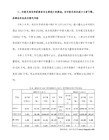
d. Results:
i. Separation of results into important and other results
d. check with simplified mechanical structure methods
e. reference calculations
7. signature of the author is required under the safety proof
8. testing by the testing engineer:
a. testing through comparison calculation
b. testing through model testing and test loads
***************************************************************************************************
2. responsibility of the testing engineer: The testing engineer has to be independent. He is responsible for the correctness and completeness of the proof of safety examination.
e. classification systems have to be described (these are coordinate systems, sign conventions for internal force and shifting variables, classification of positions, components, nodal point numbering, agreements for load cases, combination of load cases, part systems out of the whole system)
NiZn 材料
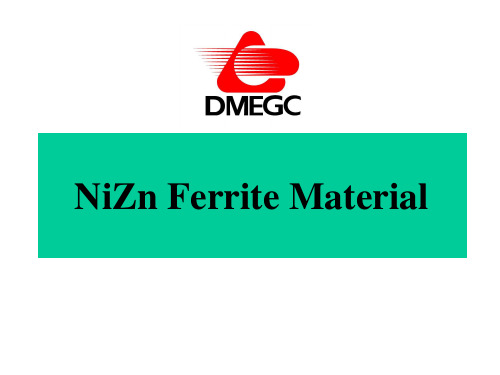
三、低温度系数镍锌铁氧体材料 Low Temperature Factor NiZn Ferrite Material
该类材料主要特点是温度系数小,工作时热稳定性好。 主要用于具有调谐电路振荡以及用于汽车电子的调谐器。 It features in lower temperature factor and better work temperature. It is mainly used in tuned circuit oscillator as well as automotive electronic tuner.
DN40B材料特性曲线 DN40B Material Characteristics Curve
DN65H材料特性曲线 DN65HCharacteristics 材料特性曲线 Curve DN65H Material
DN85H 材料特性曲线 DN85H 材料特性曲线 DN85H Material Characteristics Curve
NiZn Ferrite Material Characteristic(一)
NiZn Ferrite Material Characteristics(二)
目前已经量产及未来三年 将继续发展的材料领域
1、宽频镍锌铁氧体材料
2、高Bs镍锌铁氧体材料
3、低温度系数镍锌铁氧体材料 4、低μi 高Q 高频镍锌铁氧体材料 5、耐热冲击镍锌铁氧体材料
二、高Bs镍锌铁氧体材料 High Saturation Magnetic flux Density NiZn Ferrite Material
该类材料较一般镍锌铁氧体材料Bs高,主要应用于高频 功率电感器、功率变压器。如目前通用的高频网络变压器, 功率扼流圈、偏压振荡线圈等。 It has higher Bs than normal NiZn ferrite material and is mainly used in power inductor and power transformer,and high frequency network transformer cores, power choke coil, oscillating coil etc.
PV3410_EN_042005

Confidential. All rights reserved. No part of this document may be transmitted or reproduced without prior permission of a Standards Department of the Volkswagen Group.Parties to a contract can only obtain this standard via the B2B supplier platform “”.© VOLKSWAGEN AGT h e E n g l i s h t r a n s l a t i o n i s b e l i e v e d t o b e a c c u r a t e . I n c a s e o f d i s c r e p a n c i e s t h e G e r m a n v e r s i o n s h a l l g o v e r n .Page 2PV 3410: 2005-043.1.2 SamplingThe sampling area relevant to the material description of the PUR flexible foam has characteristics that are specific to the component and is therefore specified in the drawing. 3.2Behavior with respect to upholstery cover materialSpecimens with dimensions (70 x 70 x 30) mm, taken from any point on the PUR molded part, are covered as completely as possible with upholstery cover material. The covered specimen is positioned between two glass plates of 3 mm thickness and loaded with 100 g, including the upper glass plate.This test setup is then aged for 300 h at elevated temperature of +90 °C in mechanically circulated air and for another 300 h in humid heat at +70 °C and (100 - 6)% relative humidity. After that, the specimen is evaluated. 3.3Gross density (material density)Determination acc. to DIN EN ISO 845. The preferable specimen dimensions are (70 x 70 x 30) mm.Number of specimens: n = 5. 3.4Compression setDetermination according to DIN EN ISO 1856, method A. Number of specimens: n = 5. Compression deformation: 50%. 3.5Compression stress/compression stress changeDetermination acc. to DIN EN ISO 3386-1; but compression by 60% performed 4 times. The preferable specimen dimensions are (70 x 70 x 30) mm. The 4th compression is recorded at 40% deformation of the PUR foam.After humid aging at elevated temperature for 200 h at +90 °C and (100 - 6)% relative humidity, the 1stcompression can also be recorded at 40% deformation. Traverse speed: 100 mm/min, number of specimens: n = 5. 3.5.1Calculation of the compression stress changeFist, the compression stresses for the as-received condition and for the condition after aging at elevated temperature are determined in kPa.Then, the stress change between the 4th compression after aging at elevated temperature and the 4th compression before aging at elevated temperature (as-received condition) is calculated using the following formula:% 100[kPa]before stress [kPa]before stress after stress ×−Example:% 17.28% 100[kPa]6.48[kPa]6.48[kPa] 5.36−=×−Page 3PV 3410: 2005-04If the calculations result in a negative compression stress change, this means that the foam has become softer.A positive compression stress change means that the foam has become harder.3.6 Tensile strength and elongation at breakDetermination acc. to DIN EN ISO 1798, specimen A, but traverse speed 100 mm/min. A specimen with different dimensions in accordance with the shape of the components is permissible.3.7 Deformation diagram (hysteresis) of the seat squabA test machine according to DIN 51220 class 1 shall be used.The test is performed on a rigid, positively engaging backing.The hysteresis characteristic values are recorded in the compression test according to DIN 53579-1; representation see Appendix A.1A zero-point setting (displacement and load) is to be made after achieving the respective preliminary force.3.7.1 Stamp XXIDiameter 200 mmCurvature radius 200 mmEdge radius 5 mm3.7.1.1 ProcedureTest direction perpendicular to the test pointTest force acc. to drawingPreliminary force F v = 20 N where V = 100 mm/minLoad force set cycle F s = 600 N where V = 500 mm/minComplete unloading of the foam (-15 mm from zero point) where V = 500 mm/minPreliminary force F v = 20 N where V = 100 mm/minLoad force hysteresis F h = 600 N where V = 100 mm/minUnloading hysteresis where V = 100 mm/min3.7.1.2 Evaluation of the hysteresisIndentation depth EW [mm]Stress line, where F b = 320 NDamping characteristic value DKW [mm]Difference of unloading line F b = 320 N minus stress line F b = 320 NSpring travel (FW) [mm]Difference of unloading line F b = 480 N minus unloading line F b = 320 N3.7.1.3 Example of the indication of a foam hardnessEW XXI at 320 N: 46 mm according to PV 3410 Section 3.7 .Page 4PV 3410: 2005-043.8 Determination of the foam hardness on the finished partA test machine according to DIN 51220 class 1 shall be used.The test is performed on a rigid, positively engaging backing.Impression stamps according to DIN 53579-1 are used to record the measured values.A zero-point setting (displacement and load) is to be made after achieving the respective preliminary force.3.8.1 Stamp II for seat backrestDiameter 112.8 mmSurface 100 cm2Edge radius 1 mm3.8.1.1 ProcedureTest direction perpendicular to the test pointTest points according to drawingPreliminary force F v = 10 N where V = 100 mm/minLoad force set cycle F s = 150 N where V = 500 mm/minComplete unloading of the foam (-15 mm from zero point) where V = 500 mm/minPreliminary force F v = 10 N where V = 100 mm/minLoad force measuring cycle F m = 120 N where V = 100 mm/min3.8.1.2 Example of the indication of a foam hardnessEW II at 120 N: 10 mm according to PV 3410 Section 3.8 .3.8.2 Stamp XI for sides of seat and backrestHemisphere diameter 75 mm.3.8.2.1 ProcedureTest direction perpendicular to the test pointTest points according to drawingPreliminary force F v = 5 N where V = 100 mm/minLoad force set cycle F s = 80 N where V = 500 mm/minComplete unloading of the foam (-15 mm from zero point) where V = 500 mm/minPreliminary force F v = 5 N where V = 100 mm/minLoad force measuring cycle F m = 50 N where V = 100 mm/min3.8.2.2 Example of the indication of a foam hardnessEW XI at 50 N: 18 mm according to PV 3410 Section 3.8 .3.9 Static setDetermination based on PV 3410 Section 3.7 .Page 5PV 3410: 2005-04 3.9.1 Test sequence3.9.1.1 SeatDetermination of the seat compression distance ESW o from the compression stress-strain characteristics while at the same time recording the measured height h0 under the preliminary force F v = 20 N in the 2nd set cycle.Static pressure load with F = 320 N plus a preliminary force F v = 20 N in moist heat +40 °C with 80% relative humidity for 16 h. The pressure load is realized by means of suitable weights.After reconditioning for 24 h in the DIN 50014-23/50-2 standard climate, the seat compression distance ESW1 is determined from the compression stress-strain characteristics, while at the same time recording the measured height h1 under the preliminary force F v = 20 N in the 2nd set cycle.3.10 Calculation formulasLoss of height H = measured height h o minus measured height h1[mm] Shift in characteristic curve ESW = seat compression distance ESW1minus seat compression distance ESW o [mm] The static set is calculated by adding the loss in height H and the shift in characteristic curve ESW after static pressure loadS = H + ESW[mm]3.11 Tear propagation strengthDetermination acc. to DIN 53356. Dimensions of the trouser specimen (100 x 30 x 10) mm. Length of the incision 40 mm.4 Referenced standards*DIN 50014 Climates and their Technical Application; Standard AtmospheresDIN 51220 Materials Testing Machines; Generals for Requirements and for Verification and Calibration of Materials Testing MachinesDIN 53356 Testing of Artificial Leather and Similar Sheet Materials; Tear Growth Test DIN 53579-1 Testing of Flexible Cellular Materials; Hardness Test on Finished Parts;Indentation Test on Shaped PartsDIN EN ISO 845 Cellular Plastics and Rubbers - Determination of Apparent (Bulk) Density DIN EN ISO 1798 Flexible Cellular Polymeric Materials – Determination of Tensile Strength and Elongation at BreakDIN EN ISO 1856 Flexible Cellular Polymeric Materials – Determination of Compression Set DIN EN ISO 3386-1 Polymeric Materials, Cellular Flexible - Determination of Stress-Strain Characteristic in Compression - Part 1: Low-Density Materials.* In this section terminological inconsistencies may occur as the original titles are used.Page 6PV 3410: 2005-04 Appendix A (informative) A.1 Deformation diagram。
材料专业-专业术语中英文
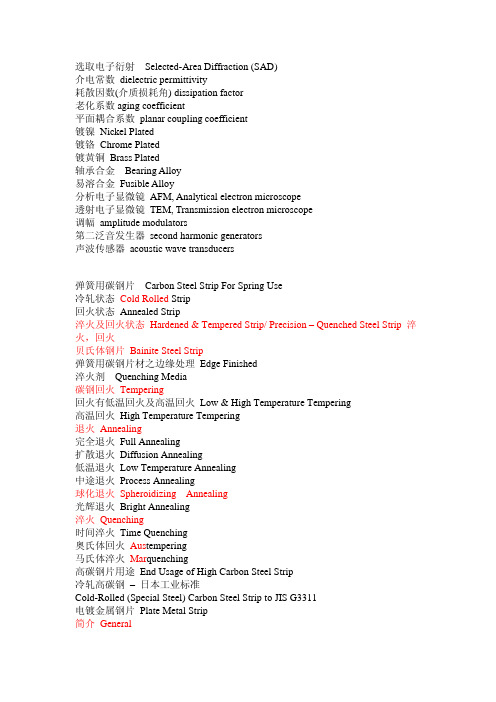
选取电子衍射Selected-Area Diffraction (SAD)介电常数dielectric permittivity耗散因数(介质损耗角) dissipation factor老化系数aging coefficient平面耦合系数planar coupling coefficient镀镍Nickel Plated镀铬Chrome Plated镀黄铜Brass Plated轴承合金Bearing Alloy易溶合金Fusible Alloy分析电子显微镜AFM, Analytical electron microscope透射电子显微镜TEM, Transmission electron microscope调幅amplitude modulators第二泛音发生器second harmonic generators声波传感器acoustic wave transducers弹簧用碳钢片Carbon Steel Strip For Spring Use冷轧状态Cold Rolled Strip回火状态Annealed Strip淬火及回火状态Hardened & Tempered Strip/ Precision – Quenched Steel Strip 淬火,回火贝氏体钢片Bainite Steel Strip弹簧用碳钢片材之边缘处理Edge Finished淬火剂Quenching Media碳钢回火Tempering回火有低温回火及高温回火Low & High Temperature Tempering高温回火High Temperature Tempering退火Annealing完全退火Full Annealing扩散退火Diffusion Annealing低温退火Low Temperature Annealing中途退火Process Annealing球化退火Spheroidizing Annealing光辉退火Bright Annealing淬火Quenching时间淬火Time Quenching奥氏体回火Aus tempering马氏体淬火Mar quenching高碳钢片用途End Usage of High Carbon Steel Strip冷轧高碳钢– 日本工业标准Cold-Rolled (Special Steel) Carbon Steel Strip to JIS G3311电镀金属钢片Plate Metal Strip简介General电镀金属捆片的优点Advantage of Using Plate Metal Strip金属捆片电镀层Plated Layer of Plated Metal Strip镀镍Nickel Plated镀铬Chrome Plated镀黄铜Brass Plated基层金属Base Metal of Plated Metal Strip低碳钢或铁基层金属Iron & Low Carbon as Base Metal不锈钢基层金属Stainless Steel as Base Metal铜基层金属Copper as Base Metal黄铜基层金属Brass as Base Metal轴承合金Bearing Alloy简介General锡基、铅基及锌基轴承合金比较表Comparison of Tin base, Lead base and Zinc base alloy for Bearing purpose易溶合金Fusible Alloy焊接合金Soldering and Brazing Alloy软焊Soldering Alloy软焊合金– 日本标准JIS H 4341 Soldering Alloy to JIS H 4341硬焊Brazing Alloy其它焊接材料请参阅日工标准目录Other Soldering Material细线材、枝材、棒材Chapter Five Wire, Rod & Bar线材/枝材材质分类及制成品Classification and End Products of Wire/Rod铁线(低碳钢线)日工标准JIS G 3532 Low Carbon Steel Wires ( Iron Wire ) to JIS G 3532光线(低碳钢线),火线(退火低碳钢线),铅水线(镀锌低碳钢线)及制造钉用低碳钢线之代号、公差及备注Ordinary Low Carbon Steel Wire, Annealed Low Carbon Steel Wire, Galvanized low Carbon Steel Wire & Low Carbon Steel Wire for nail manufacturing - classification, Symbol of Grade, Tolerance and Remarks.机械性能Mechanical Properties锌包层之重量,铜硫酸盐试验之酸洗次数及测试用卷筒直径Weight ofZinc-Coating, Number of Dippings in Cupric Sulphate Test and Diameters of Mandrel Used for Coiling Test冷冲及冷锻用碳钢线枝Carbon Steel Wire Rods for Cold Heading & Cold Forging (to JIS G3507)级别,代号及化学成份Classification, Symbol of Grade and Chemical Composition 直径公差,偏圆度及脱碳层的平均深度Diameter Tolerance, Ovality and Average Decarburized Layer Depth冷拉钢枝材Cold Drawn Carbon Steel Shafting Bar枝材之美工标准,日工标准,用途及化学成份AISI - American Iron and Steel Institute 美国钢铁学会JIS - Japanese Industrial Standards 日本工业标准AISI, JIS End Usage and Chemical Composition of Cold Drawn Carbon S teel Shafting Bar冷拉钢板重量表Cold Drawn Steel Bar Weight Table高碳钢线枝High Carbon Steel Wire Rod (to JIS G3506)冷拉高碳钢线Hard Drawn High Carbon Steel Wire化学成份分析表Chemical Analysis of Wire Rod线径、公差及机械性能(日本工业标准G 3521) Mechanical Properties (JIS G 3521) 琴线(日本标准G3522)Piano Wires ( to G3522)级别,代号,扭曲特性及可用之线材直径Classes, symbols, twisting characteristic and applied Wire Diameters直径,公差及拉力强度Diameter, Tolerance and Tensile Strength裂纹之容许深度及脱碳层Permissible depth of flaw and decarburized layer常用的弹簧不锈钢线-编号,特性,表面处理及化学成份Stainless Spring Wire – National Standard number, Charateristic, Surface finish & Chemical composition弹簧不锈钢线,线径及拉力列表Stainless Spring Steel, Wire diameter and Tensile strength of Spring Wire处理及表面状况Finish & Surface各种不锈钢线在不同处理拉力比较表Tensile Strength of various kinds of Stainless Steel Wire under Different Finish圆径及偏圆度之公差Tolerance of Wire Diameters & Ovality ovality [əu'væliti] n. 椭圆度,椭圆变形,椭圆形铬镍不锈钢及抗热钢弹簧线材– 美国材验学会ASTM A313 – 1987 Chromium – Nickel Stainless and Heat-resisting Steel Spring Wire – ASTM A313 – 1987ASTM - American Society of Testing Materials 美国材料实验协会化学成份Chemical Composition机械性能Mechanical Properties305, 316, 321及347之拉力表Tensile Strength Requirements for Types 305, 316, 321 and 347A1S1-302 贰级线材之拉力表Tensile Strength of A1S1-302 Wire日本工业标准– 不锈钢的化学成份(先数字后字母排列)JIS – Chemical Composition of Stainless Steel (in order of number & alphabet)美国工业标准– 不锈钢及防热钢材的化学成份(先数字后字母排列)AISI – Chemical Composition of Stainless Steel & Heat-Resistant Steel(in order of number & alphabet)易车碳钢Free Cutting Carbon Steels (to JIS G4804 )化学成份Chemical composition圆钢枝,方钢枝及六角钢枝之形状及尺寸之公差Tolerance on Shape and Dimensions for Round Steel Bar, Square Steel Bar, Hexagonal Steel Bar易车(快削)不锈钢Free Cutting Stainless Steel易车(快削)不锈钢种类Type of steel易车(快削)不锈钢拉力表Tensile Strength of Free Cutting Wires枝/棒无芯磨公差表(µ) (µ = 1/100 mm) Rod/Bar Centreless Grind Tolerance易车不锈钢及易车钢之不同尺寸及硬度比较Hardness of Different Types & Size of Free Cutting Steel扁线、半圆线及异形线Flat Wire, Half Round Wire, Shaped Wire and Precision Shaped Fine Wire加工方法Manufacturing Method应用材料Material Used特点Characteristic用途End Usages不锈钢扁线及半圆线常用材料Commonly used materials for Stainless Flat Wire & Half Round Wire扁线公差Flat Wire Tolerance方线公差Square Wire Tolerance锌镀层质量Zinc Coating Mass表面处理Surface Treatment冷轧钢片Cold-Rolled Steel Sheet/Strip热轧钢片Hot-Rolled Sheet Strip电解冷轧钢片厚度公差Thickness Tolerance of Electrolytic Cold-rolled sheet热轧钢片厚度公差Thickness Tolerance of Hot-rolled sheet冷轧或热轧钢片阔度公差Width Tolerance of Cold or Hot-rolled sheet长度公差Length Tolerance理论质量Theoretical Mass锌镀层质量(两个相同锌镀层厚度)Mass Calculation of coating (For equal coating)/MM锌镀层质量(两个不同锌镀层厚度) Mass Calculation of coating (For differential coating)/MM简介General镀锡薄铁片的构造Construction of Electrolytic Tinplate镀锡薄钢片(白铁皮/马日铁)制造过程Production Process of Electrolytic Tinplate 锡层质量Mass of Tin Coating (JIS G3303-1987)两面均等锡层Both Side Equally Coated Mass两面不均等锡层Both Side Different Thickness Coated Mass级别、电镀方法、镀层质量及常用称号Grade, Plating type, Designation of Coating Mass & Common Coating Mass镀层质量标记Markings & Designations of Differential Coatings硬度Hardness单相轧压镀锡薄铁片(白铁皮/马口铁) Single-Reduced Tinplate双相辗压镀锡薄钢片(马口铁/白铁皮) Dual-Reduction Tinplate钢的种类Type of Steel表面处理Surface Finish常用尺寸Commonly Used Size电器用硅[硅] 钢片Electrical Steel Sheet简介General软磁材料Soft Magnetic Material滞后回线Narrow Hystersis矫顽磁力Coercive Force硬磁材料Hard Magnetic Material最大能量积Maximum Energy Product硅含量对电器用的低碳钢片的最大好处The Advantage of Using Silicon low Carbon Steel晶粒取向(Grain-Oriented)及非晶粒取向(Non-Oriented) Grain Oriented &Non-Oriented电器用硅[硅] 钢片的最终用途及规格End Usage and Designations of Electrical Steel Strip电器用的硅[硅] 钢片之分类Classification of Silicon Steel Sheet for Electrical Use电器用钢片的绝缘涂层Performance of Surface Insulation of Electrical Steel Sheets 晶粒取向电器用硅钢片主要工业标准International Standard – Grain-Oriented Electrical Steel Silicon Steel Sheet for Electrical Use晶粒取向电器用硅钢片Grain-Oriented Electrical Steel晶粒取向,定取向芯钢片及高硼定取向芯钢片之磁力性能及夹层系数(日工标准及美材标准)Magnetic Properties and Lamination Factor of SI-ORIENT-CORE&SI-ORIENT-CORE-HI B Electrical Steel Strip (JIS and AISI Standard)退火Annealing电器用钢片用家需自行应力退火原因Annealing of the Electrical Steel Sheet退火时注意事项Annealing Precautionary碳污染Prevent Carbon Contamination热力应先从工件边缘透入Heat from the Laminated Stacks Edges提防过份氧化No Excessive Oxidation应力退火温度Stress –relieving Annealing Temperature晶粒取向电器用硅[硅] 钢片– 高硼(HI-B)定取向芯钢片及定取向芯钢片之机械性能及夹层系数Mechanical Properties and Lamination Factors of SI-ORIENT-CORE-HI-B andSI-ORIENT-CORE Grain Orient Electrical Steel Sheets晶粒取向电器用硅[硅] 钢;片– 高硼低硫(LS)定取向钢片之磁力及电力性能Magnetic and Electrical Properties of SI-ORIENT-CORE-HI-B-LS晶粒取向电器用硅[硅] 钢片– 高硼低硫(LS) 定取向钢片之机械性能及夹层系数Mechanical Properties and Lamination Factors of SI-ORIENT-CORE-HI-B-LS晶粒取向电器用硅(硅)钢片-高硼(HI-B)定取向芯钢片,定取向芯钢片及高硼低硫(LS)定取向芯钢片之厚度及阔度公差Physical Tolerance of SI-ORIENT-CORE-HI-B, SI-ORIENT-CORE, &SI-CORE-HI-B-LS Grain Oriented Electrical Steel Sheets晶粒取向电器用硅(硅)钢片– 高硼(HI-B)定取向芯钢片,定取向芯钢片及高硼低硫(LS)定取向芯钢片之标准尺寸及包装Standard Forms and Size of SI-ORIENT-CORE-HI-B,SI-CORE, &SI-ORIENT-CORE-HI-B-LS Grain- Oriented Electrical Steel Sheets绝缘表面Surface Insulation非晶粒取向电力用钢片的电力、磁力、机械性能及夹层系数Lamination Factors of Electrical, Magnetic & Mechanical Non-Grain Oriented Electrical电器及家电外壳用镀层冷辘[低碳] 钢片Coated (Low Carbon) Steel Sheets for Casing,Electricals & Home Appliances镀铝硅钢片Aluminized Silicon Alloy Steel Sheet简介General镀铝硅合金钢片的特色Feature of Aluminized Silicon Alloy Steel Sheet用途End Usages抗化学品能力Chemical Resistance镀铝(硅)钢片– 日工标准(JIS G3314)Hot-aluminum-coated sheets and coils to JIS G 3314镀铝(硅)钢片– 美材试标准(ASTM A-463-77)35.7 JIS G3314镀热浸铝片的机械性能Mechanical Properties of JIS G 3314 Hot-Dip Aluminum-coated Sheetsand Coils公差Size Tolerance镀铝(硅)钢片及其它种类钢片的抗腐蚀性能比较Comparsion of various resistance of aluminized steel & other kinds of steel镀铝(硅)钢片生产流程Aluminum Steel Sheet, Production Flow Chart焊接能力Weldability镀铝钢片的焊接状态(比较冷辘钢片)Tips on welding of Aluminized sheet in comparasion with cold rolled steel strip钢板Steel Plate钢板用途分类及各国钢板的工业标准包括日工标准及美材试标准Type of steel Plate & Related JIS, ASTM and Other Major Industrial Standards钢板生产流程Production Flow Chart钢板订货需知Ordering of Steel Plate不锈钢Stainless Steel不锈钢的定义Definition of Stainless Steel不锈钢之分类,耐腐蚀性及耐热性Classification, Corrosion Resistant & Heat Resistance of Stainless Steel铁铬系不锈钢片Chrome Stainless Steel马氏体不锈钢Martensite Stainless Steel低碳马氏体不锈钢Low Carbon Martensite Stainless Steel含铁体不锈钢Ferrite Stainless Steel镍铬系不锈钢Nickel Chrome Stainless Steel释出硬化不锈钢Precipitation Hardening Stainless Steel铁锰铝不锈钢Fe / Mn / Al / Stainless Steel不锈钢的磁性Magnetic Property & Stainless Steel不锈钢箔、卷片、片及板之厚度分类Classification of Foil, Strip, Sheet & Plate by Thickness表面保护胶纸Surface protection film不锈钢片材常用代号Designation of SUS Steel Special Use Stainless表面处理Surface finish薄卷片及薄片(0.3至2.9mm厚之片)机械性能Mechanical Properties of Thin Stainless Steel(Thickness from 0.3mm to 2.9mm) – strip/sheet不锈钢片机械性能(301, 304, 631, CSP)Mechanical Properties of Spring use Stainless Steel不锈钢– 种类,工业标准,化学成份,特点及主要用途Stainless Steel – Type, Industrial Standard, Chemical Composition, Characteristic & end usage of the most commonly used Stainless Steel不锈钢薄片用途例End Usage of Thinner Gauge不锈钢片、板用途例Examples of End Usages of Strip, Sheet & Plate不锈钢应力退火卷片常用规格名词图解General Specification of Tension Annealed Stainless Steel Strips耐热不锈钢Heat-Resistance Stainless Steel镍铬系耐热不锈钢特性、化学成份、及操作温度Heat-Resistance Stainless Steel 铬系耐热钢Chrome Heat Resistance Steel镍铬耐热钢Ni - Cr Heat Resistance Steel超耐热钢Special Heat Resistance Steel抗热超级合金Heat Resistance Super Alloy耐热不锈钢比重表Specific Gravity of Heat – resistance steel plates and sheets stainless steel不锈钢材及耐热钢材标准对照表Stainless and Heat-Resisting Steels发条片Power Spring Strip发条的分类及材料Power Spring Strip Classification and Materials上链发条Wind-up Spring倒后擦发条Pull Back Power Spring圆面("卜竹")发条Convex Spring Strip拉尺发条Measure Tape魔术手环Magic Tape魔术手环尺寸图Drawing of Magic Tap定型发条Constant Torque Spring定型发条及上炼发条的驱动力Spring Force of Constant Torque Spring and Wing-up Spring定型发条的形状及翻动过程Shape and Spring Back of Constant Torque Spring定型发条驱动力公式及代号The Formula and Symbol of Constant Torque Spring边缘处理Edge Finish硬度Hardness高碳钢化学成份及用途High Carbon Tool Steel, Chemical Composition and Usage每公斤发条的长度简易公式The Length of 1 Kg of Spring Steel StripSK-5 & AISI-301 每公斤长的重量/公斤(阔100-200公厘) Weight per one meter long (kg) (Width 100-200mm)SK-5 & AISI-301 每公斤之长度(阔100-200公厘) Length per one kg (Width100-200mm)SK-5 & AISI-301 每公尺长的重量/公斤(阔2.0-10公厘)Weight per one meter long (kg) (Width 2.0-10mm)SK-5 & AISI-301 每公斤之长度(阔2.0-10公厘)Length per one kg (Width 2.0-10mm)高碳钢片High Carbon Steel Strip分类Classification用组织结构分类Classification According to Grain Structure用含碳量分类– 即低碳钢、中碳钢及高碳钢Classification According to Carbon Contains物料科学Material Science物料科学定义Material Science Definition加工性能Machinability强度Strength抗腐蚀及耐用Corrosion & resistance durability金属特性Special metallic features抗敏感及环境保护Allergic, re-cycling & environmental protection化学元素Chemical element元素的原子序数Atom of Elements原子及固体物质Atom and solid material原子的组成、大小、体积和单位图表The size, mass, charge of an atom, and is particles (Pronton,Nentron and Electron)原子的组织图Atom Constitutes周期表Periodic Table原子键结Atom Bonding金属与合金Metal and Alloy铁及非铁金属Ferrous & Non Ferrous Metal金属的特性Features of Metal晶体结构Crystal Pattern晶体结构,定向格子及单位晶格Crystal structure, Space lattice & Unit cellX线结晶分析法X – ray crystal analyics method金属结晶格子Metal space lattice格子常数Lattice constant米勒指数Miller's Index金相及相律Metal Phase and Phase Rule固熔体Solid solution置换型固熔体Substitutional type solid solution插入型固熔体Interstital solid solution金属间化物Intermetallic compound金属变态Transformation变态点Transformation Point磁性变态Magnetic Transformation同素变态Allotropic Transformation合金平衡状态Thermal Equilibrium相律Phase Rule自由度Degree of freedom临界温度Critical temperture共晶Eutectic包晶温度Peritectic Temperature包晶反应Peritectic Reaction包晶合金Peritectic Alloy亚共晶体Hypoeutetic Alloy过共晶体Hyper-ectectic Alloy金属的相融、相融温度、晶体反应及合金在共晶合金、固熔孻共晶合金及偏晶反应的比较Equilibrium Comparision金属塑性Plastic Deformation滑动面Slip Plan畸变Distortion硬化Work Hardening退火Annealing回复柔软Crystal Recovery再结晶Recrystallization金属材料的性能及试验Properties & testing of metal化学性能Chemical Properties物理性能Physical Properties颜色Colour磁性Magnetisum比电阻Specific resistivity & specific resistance比重Specific gravity & specific density比热Specific Heat热膨胀系数Coefficient of thermal expansion导热度Heat conductivity机械性能Mechanical properties屈服强度(降伏强度) (Yield strangth)弹性限度、阳氏弹性系数及屈服点elastic limit, Yeung's module of elasticity to yield point伸长度Elongation断面缩率Reduction of area金属材料的试验方法The Method of Metal inspection不破坏检验Non – destructive inspections渗透探伤法Penetrate inspection磁粉探伤法Magnetic particle inspection放射线探伤法Radiographic inspection超声波探伤法Ultrasonic inspection显微观察法Microscopic inspection破坏的检验Destructive Inspection冲击测试Impact Test疲劳测试Fatigue Test潜变测试Creep Test潜变强度Creeps Strength第壹潜变期Primary Creep第二潜变期Secondary Creep第三潜变期Tertiary Creep主要金属元素之物理性质Physical properties of major Metal Elements工业标准及规格– 铁及非铁金属Industrial Standard – Ferrous & Non – ferrous Metal磁力Magnetic简介General软磁Soft Magnetic硬磁Hard Magnetic磁场Magnetic Field磁性感应Magnetic Induction透磁度Magnetic Permeability磁化率Magnetic Susceptibility (Xm)磁力(Magnetic Force)及磁场(Magnetic Field)是因物料里的电子(Electron)活动而产生抗磁体、顺磁体、铁磁体、反铁磁体及亚铁磁体Diamagnetism, Paramagnetic, Ferromagnetism,Antiferromagnetism & Ferrimagnetism抗磁体Diamagnetism磁偶极子Dipole负磁力效应Negative effect顺磁体Paramagnetic正磁化率Positive magnetic susceptibility铁磁体Ferromagnetism转变元素Transition element交换能量Positive energy exchange外价电子Outer valence electrons化学结合Chemical bond自发上磁Spontaneous magnetization磁畴Magnetic domain相反旋转Opposite span比较抗磁体、顺磁体及铁磁体Comparison of Diamagnetism, Paramagnetic & Ferromagnetism反铁磁体Antiferromagnetism亚铁磁体Ferrimagnetism磁矩magnetic moment净磁矩Net magnetic moment钢铁的主要成份The major element of steel钢铁用"碳"之含量来分类Classification of Steel according to Carbon contents 铁相Steel Phases钢铁的名称Name of steel纯铁体Ferrite渗碳体Cementitle奥氏体Austenite珠光体及共释钢Pearlite &Eutectoid奥氏体碳钢Austenite Carbon Steel单相金属Single Phase Metal共释变态Eutectoid Transformation珠光体Pearlite亚铁释体Hyppo-Eutectoid初释纯铁体Pro-entectoid ferrite过共释钢Hype-eutectoid珠光体Pearlite粗珠光体Coarse pearlite中珠光体Medium pearlite幼珠光体Fine pearlite磁性变态点Magnetic Transformation钢铁的制造Manufacturing of Steel连续铸造法Continuous casting process电炉Electric furnace均热炉Soaking pit全静钢Killed steel半静钢Semi-killed steel沸腾钢(未净钢) Rimmed steel钢铁生产流程Steel Production Flow Chart钢材的熔铸、锻造、挤压及延轧The Casting, Fogging, Extrusion, Rolling & Steel熔铸Casting锻造Fogging挤压Extrusion延轧Rolling冲剪Drawing & stamping特殊钢Special Steel简介General特殊钢以原素分类Classification of Special Steel according to Element特殊钢以用途来分类Classification of Special Steel according to End Usage易车(快削)不锈钢Free Cutting Stainless Steel含铅易车钢Leaded Free Cutting Steel含硫易车钢Sulphuric Free Cutting Steel硬化性能Hardenability钢的脆性Brittleness of Steel低温脆性Cold brittleness回火脆性Temper brittleness日工标准下的特殊钢材Specail Steel according to JIS Standard铬钢– 日工标准JIS G4104 Chrome steel to JIS G4104铬钼钢钢材– 日工标准G4105 62 Chrome Molybdenum steel to JIS G4105镍铬– 日工标准G4102 63 Chrome Nickel steel to JIS G4102镍铬钼钢– 日工标准G4103 64 Nickel, Chrome & Molybdenum Steel to JISG4103高锰钢铸– 日工标准High manganese steel to JIS standard片及板材Chapter Four-Strip, Steel & Plate冷辘低碳钢片(双单光片)(日工标准JIS G3141) 73 - 95Cold Rolled (Low carbon) Steel Strip (to JIS G 3141)简介General美材试标准的冷辘低碳钢片Cold Rolled Steel Strip American Standard – American Society for testing and materials (ASTM)日工标准JIS G3141冷辘低碳钢片(双单光片)的编号浅释Decoding of cold rolled(Low carbon)steel strip JIS G3141材料的加工性能Drawing abillity硬度Hardness表面处理Surface finish冷辘钢捆片及张片制作流程图表Production flow chart cold rolled steel coil sheet冷辘钢捆片及张片的电镀和印刷方法Cold rolled steel coil & sheet electro-plating & painting method冷辘(低碳)钢片的分类用、途、工业标准、品质、加热状态及硬度表End usages, industrial standard, quality, condition and hardness of cold rolled steel strip硬度及拉力Hardness & Tensile strength test拉伸测试(顺纹测试) Elongation test杯突测试(厚度: 0.4公厘至1.6公厘,准确至0.1公厘3个试片平均数) Erichsen test (Thickness: 0.4mm to 1.6mm, figure round up to 0.1mm)曲面(假曲率) Camber厚度及阔度公差Tolerance on Thickness & Width平坦度(阔度大于500公厘,标准回火) Flatness (width>500mm, temper: standard) 弯度Camber冷辘钢片储存与处理提示General advice on handling & storage of cold rolled steel coil & sheet防止生锈Rust Protection生锈速度表Speed of rusting焊接Welding气焊Gas Welding埋弧焊Submerged-arc Welding电阻焊Resistance Welding冷辘钢片(拉力: 30-32公斤/平方米)在没有表面处理状态下的焊接状况Spot welding conditions for bared (free from paint, oxides etc) Coldrolled mild steel sheets(T/S:30-32 Kgf/ µ m2)时间效应(老化)及拉伸应变Aging & Stretcher Strains日工标准(JIS G3141)冷辘钢片化学成份Chemical composition – cold rolled steel sheet to JIS G3141冷辘钢片的"理论重量"计算方程式Cold Rolled Steel Sheet – Theoretical mass日工标准(JIS G3141)冷辘钢片重量列表Mass of Cold-Rolled Steel Sheet to JIS G3141冷辘钢片订货需知Ordering of cold rolled steel strip/sheet其它日工标准冷轧钢片(用途及编号)JIS standard & application of other cold Rolled Special Steel电镀锌钢片或电解钢片Electro-galvanized Steel Sheet/Electrolytic Zinc Coated Steel Sheet简介General电解/电镀锌大大增强钢片的防锈能力Galvanic Action improving Weather & Corrosion Resistance of the BaseSteel Sheet上漆能力Paint Adhesion电镀锌钢片的焊接Welding of Electro-galvanized steel sheet点焊Spot welding滚焊Seam welding电镀锌(电解)钢片Electro-galvanized Steel Sheet生产流程Production Flow Chart常用的镀锌钢片(电解片)的基层金属、用途、日工标准、美材标准及一般厚度刃位错、螺位错(edge dislocation、screw dislocation)孪晶界(twin boundary)晶界(grain boundary匀晶相图somorphous共晶反应(e utectic reaction)包晶反应(peritectic reaction铁素体α (ferrite)奥氏体γ(austenite)珠光体(pearlite)固溶体(solid solution)能带(energy band)空带(vacancy band)导带(conduction band)价带(valence band)禁带(forbidden band)能隙(energy gap)弹性(elastic property)塑性(plasticity)延伸率(percentage of elongation)延伸率指的是试样拉断后标距的伸长和原始标距的百分比。
高压XLPE电缆缓冲层缺陷研究现状综述

绝缘材料 2024,57(4)邱玮等:高压XLPE电缆缓冲层缺陷研究现状综述高压XLPE电缆缓冲层缺陷研究现状综述邱玮1,章宇聪1,2,谢亿2,曹先慧2,刘维可2,胡俊3,李湘珺1(1.长沙理工大学能源与动力工程学院,湖南长沙410114;2.国网湖南省电力有限公司电力科学研究院,湖南长沙410007;3.湖南省湘电锅炉压力容器检验中心有限公司,湖南长沙410208)摘要:高压交联聚乙烯电缆因缓冲层缺陷引发的故障频发,已严重威胁到电力系统的安全运行。
本文首先介绍了缓冲层的基本结构和作用,并在此基础上梳理了目前国内外对于缓冲层失效的相关研究;其次从缓冲层的材料特征和内部结构等角度结合电场仿真来分析缺陷发生的主要原因;之后对缓冲层缺陷中出现的白色粉末绝缘性能和理化特征进行总结,并提出其形成机理;最后对缓冲层缺陷的检测手段进行汇总,提出使用计算机断层成像技术对电缆缓冲层缺陷进行检测以弥补现有检测手段的不足,并建议对铝护套及缓冲层的材料或结构进行优化,以预防缓冲层缺陷的生成。
关键词:高压电缆;交联聚乙烯;缓冲层缺陷;计算机断层成像;平滑铝护套中图分类号:TM247 DOI:10.16790/ki.1009-9239.im.2024.04.002Summary of research status on buffer layer defects inhigh voltage XLPE cablesQIU Wei1, ZHANG Yucong1,2, XIE Yi2, CAO Xianhui2, LIU Weike2, HU Jun3, LI Xiangjun1(1. College of Energy and Power Engineering, Changsha University of Science & Technology,Changsha 410114, China;2. State Grid Hunan Electric Power Corporation Research Institute, Changsha 410007, China;3. Hunan Xiangdian Boiler and Pressure Vessel Inspection Center Co., Ltd., Changsha 410208, China)Abstract: The frequent faults caused by buffer layer defects in high-voltage cross-linked polyethylene cables have seriously threatened the safe operation of power system. In this paper, the basic structure and function of buffer layers was introduced at first, and the relevant research on buffer layer failure at home and abroad were summarized. Secondly, the main reason of buffer layer defects was analyzed through electric field simulation from the material characteristic and internal structure of buffer layers, and the insulating properties and physicochemical characteristics of the white powder in buffer layer were summarized to propose its formation mechanism. Finally, the detection methods of buffer layer defects were summarized, it is proposed to use computer tomography technology to detect cable buffer layer defects to make up for the shortcomings of existing detection methods, and it is recommended to optimize the materials or structures of aluminum sheaths and buffer layers to prevent the generation of buffer layer defects.Key words: high voltage cables; crosslinked polyethylene; buffer layer defects; computed tomography; smooth aluminum sheath0 引言随着我国经济的快速发展和城镇化的不断推进,电力需求猛增。
热敏电阻介绍教学幻灯片

Type J : V (mV) / T (C) Table
Deg C
020 -0.995 -1.093 -1.19 -1.288 -1.385
-10 -0.501 -0.6 -0.699 -0.798 -0.896
0
0 -0.101 -0.201 -0.301 -0.401
TCR Tolerance %
1% 1% 1% 0.12% 0.35% 1% 0.35% 1% 0.35% 0.1%
Thermocouple
Type: K, E, J, N ,B, R, S Material: Pt –Rhodium, W- Rhenium, Constantan, Cupron Principle: Seebeck effect that the junction between two metals generates a voltage which is a function of temperature Typical performance: See below table Features: interchangeable, wide range of temperatures
Thermocouple type
Overall range °C
B(Platinum / Rhodium) 20 to 1820
E(Chromel / Constantan) -270 to 910
J (Iron / Constantan) -210 to 1200
K(Chromel / Alumel) -270 to 1370
Type
CB CC NA PA PB PC PE PF PG PH
Element Material
Sn0.7Cu无铅锡条产品介绍 中英文版

产品介绍Product Introduction一、适用范围Scope1.1该承认书只适用于本公司的指定产品:无铅产品。
但因应客户要求,该资料可以免费分发交付客户使用。
The acceptance is just only applicable to the designated lead-free products of the company.But according toclients requirements,the files can be distributed to them for free.The file is suitable for any wire diameter ofthe same alloy composition and flux percentage.1.2本产品应用于环保要求严格的人工焊接和自动焊接。
由高纯度原材料精制而成,在环保型电子装配工业中有广泛应用。
产品执行标准:GB/T20422-2018。
This product is applied for strict environmental requirements of manual welding and automatic welding.Refined with high purity of raw materials,and used widely in environmental electronic assembly industry.Product Executive Standard:GB/T20422-2018.二、产品信息Product information2.1产品名称:无铅锡条Product Name:Lead-free Solder Bar2.2产品型号:107HProduct Model:107H2.3合金规格:Sn-0.7CuAlloy Specification:Sn-0.7Cu2.4产品形状:固体条状Product Shape:solid strip2.5产品特点Product Characteristics2.5.1金属杂质、氧化物含量低。
(完整word版)废弃电路板的综合处理与回收利用技术.
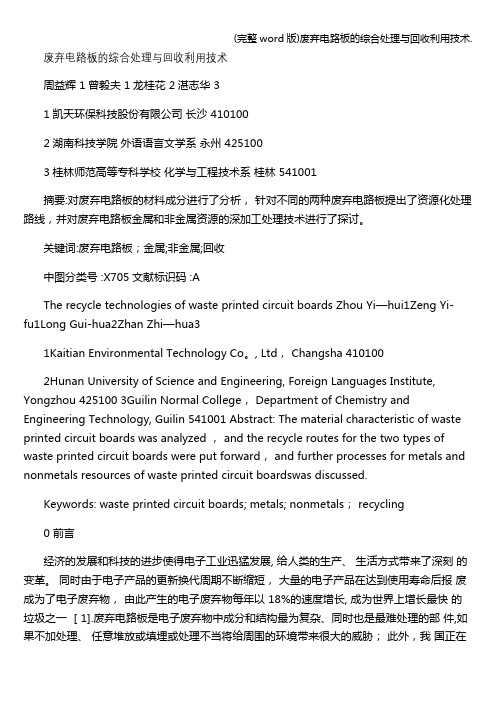
废弃电路板的综合处理与回收利用技术周益辉 1曾毅夫 1龙桂花 2湛志华 31凯天环保科技股份有限公司长沙 4101002湖南科技学院外语语言文学系永州 4251003桂林师范高等专科学校化学与工程技术系桂林 541001摘要:对废弃电路板的材料成分进行了分析,针对不同的两种废弃电路板提出了资源化处理路线,并对废弃电路板金属和非金属资源的深加工处理技术进行了探讨。
关键词:废弃电路板;金属;非金属;回收中图分类号 :X705文献标识码 :AThe recycle technologies of waste printed circuit boards Zhou Yi—hui1Zeng Yi-fu1Long Gui-hua2Zhan Zhi—hua31Kaitian Environmental Technology Co。
, Ltd, Changsha 4101002Hunan University of Science and Engineering, Foreign Languages Institute, Yongzhou 425100 3Guilin Normal College, Department of Chemistry and Engineering Technology, Guilin 541001 Abstract: The material characteristic of waste printed circuit boards was analyzed , and the recycle routes for the two types of waste printed circuit boards were put forward, and further processes for metals and nonmetals resources of waste printed circuit boardswas discussed.Keywords: waste printed circuit boards; metals; nonmetals; recycling0 前言经济的发展和科技的进步使得电子工业迅猛发展, 给人类的生产、生活方式带来了深刻的变革。
木鱼花(共3篇)

木鱼花(共3篇)木鱼花(一): 用英语介绍世界各地的美食并描述一种美食的制作过程最好用表格的形式food country material characteristic****马来西亚肉骨茶原料:猪腔排骨1500克.肉骨茶料包:党参20克、枸杞子8克、川穹3克、桂枝3克、当归2克、麦冬5克、陈皮1片、罗汉果1/4片、甘草2克、黑胡椒粒1/4小匙、小茴香1/4小匙、花椒1/4小匙、乌枣5颗、桂皮1片.调料:大蒜1整头、酱油30ml、白胡椒粉1小匙、白砂糖1勺、盐适量. 做法:1、将肉骨茶调料分别称好;2、一起装入料包内扎紧收口制成肉骨茶料包备用;3、大蒜掰开成单瓣保留外皮洗净备用;4、锅内做水,水开后下入腔排骨焯烫;5、焯烫约5分钟左右至表面变色后捞出控干水分;6、另取一锅做水,水开后下入大蒜瓣和肉骨茶料包;7、汤中加入白胡椒粉,糖和酱油;8、下入焯烫好的腔排骨;9、开锅后盖锅盖儿转小火炖煮一个半小时左右后加盐调味制作完成,食用时配上凉油条.碎嘴唠叨:1、肉骨茶料包中的调料有些可在调料市场中买到,没有的可去中药店采买(均属于常用药材,价格便宜).2、除了料包的配置,此菜可谓零失败菜品,适合初学者尝试并增加自信心.3、煮肉骨的汤一定要量大一些,一次加够,实在没加够的话也要注意添加开水.4、做好的肉骨茶配以凉油条食用可谓一绝,没有剩油条用米饭采用汤儿泡饭的手法也是不错.5、肉骨茶有去湿,旺血,暖胃,补气,养颜等诸多功效,男女筒子皆宜.但高血脂,高血压应该筒子尽量少食.Malaysia bak teaIngredients:Pig cavity ribs 1500 g.Bak tea material package:Dangshen 20 grams, medlar eight grams, sichuan vault 3 grams, cassia twig 3 grams, angelica 2 grams, radix ophiopogonis 5 grams, 1 dried tangerine peel, luohan 1/4, liquorice, black pepper, 2 spoon, cummin 1/4 small spoon, Chinese prickly ash 1/4 small spoon, WuZao 5 star, cinnamon, 1 slice.Seasoning: garlic, 1 whole 30ml, white pepper sauce, 1 small spoon, sugar, salt, 1 spoon.Methods:1, will bak tea condiment respectively; say2 and package materials together into tight binding material made of meat bone tea bag spare,3, garlic break into single cortical reserves wash spare,4 and the pot of water to a boil, do the ironing; Chao ribs cavity5 and Chao hot about five minutes to remove the surface color drain,6 and the other a pot of water to boil water, after doing the same and the big meat bone tea materials bag,7, soup, add sugar and white pepper sauce,8 and the Chao hot good cavity ribs,9 and KaiGuo cover pot son turn small fire after one and a half hours to sprinkle salt production, serve with the cool twisted dough-strips.Broken mouth nagging:1 and the mixture bak tea bag seasoning in some markets buy seasoning, the medicine can not go shopping (belong to common herbs, cheap price).2, besides the configuration of that package material, this dish is zero, and is suitable for beginners to fail dishes and increasingself-esteem.3 and boiled meat bone soup must measure, add enough time, can"t add enough water to note also added.Four, the match with cool twisted dough-strips edible is special, no ShengYou bar with rice soup PaoFan son by the technique is good.5 and bak tea has to wet and warm blood, wang stomach, tonifying qi, etc., and suitable bobbin. But the blood pressure should be less as far as possible, the cheese.蛋黄培根意面(1人份)原料:意面100g、熟咸蛋黄2个、培根几片、盐.做法:1、培根切碎入锅煎熟.不用放油,培根一煎会出油.2、锅里烧开水,加适量盐煮熟意面,捞出备用.3、加入煎熟的培根,熟咸蛋黄,拌匀即可.Yolk Peigenyi is weak (1 people share) Raw material: Expect 100gs , salty ripe 2 yolks , several pieces of Bacons , salt. Method of work: 1, Bacon cut up enter a boiler fry familiar. Nonutility lets go of oil , Bacon once fries to be going to be oily out. 2, heats boiled water in the boiler , adds appropriate amount salt cook intention face thoroughly , fishes up standby. 3, adds the fry familiar Bacon , ripe salty yolk , mixes evenly to be OK.韩国馒头原料:高粉175克、低粉75克、酵母2克、盐1克、鸡蛋1个、牛奶100克,、糖50克、泡打粉2克.底部沾粉原料:白糖5克、低筋面粉10克、芝麻5克.做法:1、将原料放入面包桶;2、用甜面包程序搅拌好后,如果手揉可以揉到扩展阶段,发酵至两倍大;3、取出分成12份,醒10分钟;4、取其中一份擀长至20厘米;5、卷起,封口处沾点水防脱,醒10分钟;6、从中间对切;7、切口向下,用手按扁;8、每个面团中间按一个小洞;9、准备底部沾粉原料;10、将小面团沾点水,放入芝麻粉中;11、再放入涂过油的8寸烤盘中;12、放温暖处发酵;13、发酵好后的样子;14、馒头上面涂油;15、倒入适量的油,家里做放底部全部有油就可以了;16、烤箱230度第三层烤12分钟左右.South Korea steamed breadIngredients:High and low powder, powder 175 75 grams, yeast, salt, 1 February 1, milk, eggs, sugar, 100 grams of 50 grams, baking powder, 2 grams. At the bottom of the material: with powder,5 grams of sugar, flour, 10 grams, sesame reinforced 5 grams.Methods:1, raw material into bread barrels,2, with sweet bread, if after mixing procedure can be extended to rub rub stage, fermentation to twice the size,3 and remove into 12, 10 minutes,4, take one roll to 20 centimeters long,5 and the seal up, with water resistance from 10 minutes; awake, From the middle of June, cutting,7 and incision with hands down, flat,8, each according to a small hole among the dough,Nine, with powder materials to bottom,10 and with little dough, sesame powder in water,11, add a greased baking pan; 8"12 and warm place,13 after fermentation, the appearance,14, steamed bread coated oil,15 and the amount of oil, and pour at home doing all have put bottom oil could,16 and layer 3 bake oven 230 degrees 12 minutes.日式煎饼原料:圆白菜1/4棵、胡萝卜丝1小撮、面粉200克、鸡蛋1个、水适量、木鱼花随意.调料:盐5克,美式芥末酱,或者沙拉酱、绿芥末.做法:1、圆白菜取叶子部分切丝,粗丝随个人喜好;2、胡萝卜去皮后擦细丝3、鸡蛋、面粉和水混合在一起搅成面糊,把圆白菜丝和胡萝卜丝放入搅拌均匀,同时放入盐调味;4、用平底锅烧热锅,将面糊倒入两面煎熟即可,煎个过程要保持中小火,吃的时候别忘了沙拉酱,还有木鱼花~~Japanese-style pancakeIngredients: cabbage 1 / 4, 1 handful of carrots, 200 grams of flour, 1 egg, adequate water, wooden fish flowers at random.Seasoning: salt 5 grams, American mustard sauce, or salad dressing, green mustard.Practice:1 cabbage leaves to take some strips, thick wire as you like;2 carrots peeled rub filaments after3, eggs, flour and water mixed with Jiaocheng batter, the cabbage and carrot into the wire Stir, and add salt;4 burning wok pan, pour the batter can be cooked on both sides, frya process to keep the small fire, do not forget to eat when the salad dressing, as well as wooden fish flower ~ ~墨西哥牛油果沙拉原料:牛油果、西红柿、墨西哥辣椒、甜洋葱、青柠、橄榄油、大蒜、黑胡椒粒、盐.做法:1、各种材料洗净备齐;2、牛油果、西红柿(去籽)、墨西哥辣椒(去籽)、甜洋葱切成相同大小的小粒;3、大蒜剁成蒜茸,加入适量青柠汁、橄榄油、黑胡椒粒、盐搅拌均匀;4、将所有处理好的材料混合均匀即可.贴心提示:1、牛油果也叫鳄梨,各大进口超市可以买到,挑选的时候摸起来不太软,果蒂一碰即掉的为好;2、洋葱最好选偏甜的品种,紫色洋葱过于辛辣,比较不适宜;3、黑胡椒粒在西餐中最常见,切忌用中式胡椒粉代替,墨西哥辣椒肥厚火辣,可用同类的其它辣椒代替;4、成品可以搭配墨西哥式玉米片食用,风味更加.Mexican avocado saladMaterial:Avocado, tomatoes, Mexican pepper, sweet onion, lime, olive oil, garlic, black pepper, salt.Practice:1, a variety of materials, clean get ready;2, avocado, tomatoes (seeded), Mexico peppers (seeded), sweet onion cut into pellets of the same size;3 garlic chopped garlic, add a moderate lime juice, olive oil, black pepper, salt, stir well;4, all dealing with good material mixed evenly.Tips:1 avocado, also known as avocado, major supermarkets can buy imports, the selection of the time feels very soft, stem end down for a touch that is good;2, the best selection bias sweet onion varieties, purple onion wastoo spicy, more suitable;3, black pepper in the Western most common, should not use pepper instead of Chinese, Mexican hot pepper hypertrophy, similar to other hot pepper can be used to replace;4, finished products can be consumed with Mexican-style corn flakes, the flavor even more.法式烩土豆原料:土豆、洋葱、芹菜、香叶2片.调料:盐、胡椒粉、白葡萄酒、黄油(或食用油).做法:1、土豆去皮切成小粒,洋葱切小块,芹菜切碎.2、将黄油放锅里化开,放入土豆稍炒,加入洋葱,倒入白葡萄酒、盐、胡椒粉、2片香叶,用小火烩20分钟.最后加入芹菜末就好了.French Stewed potatoesMaterial:Potatoes, onions, celery, geraniol 2.Seasoning:Salt, pepper, white wine, butter (or oil).Practice:1 Peel potatoes into pellets, cut into small pieces onion, chopped celery.2, put the pot of butter to open, put a bit fried potatoes, add onion, pour in white wine, salt, pepper, 2 Heung Yip, Braised low heat 20 minutes. Finally add celery late enough.【木鱼花】木鱼花(二): 日本料理的步骤以及菜品【木鱼花】日式铁板烧较之传统的日本料理,要高出一个档次,即使在日本很多人也不常光顾,请客吃它已是不低的礼遇.原因在于铁板烧会选用最上乘的材料,例如新鲜的海鲜,包括龙虾、带子、鲍鱼等.同时材料在制作之前不经过腌制,只在烧烤过程中加入盐、胡椒两种调味品,品的是食物的原始味道.大家围坐在大而扁平的铁板周围,烧热铁板后擦油,放上原料煎熟,厨师当场操作,边吃边煎.日式铁板烧是较高档的日本料理.日式铁板烧首先要求原料的高品质和绝对新鲜,制作之前不经过腌制,只在烧烤过程中加入盐、胡椒两种调味品,品的是食物的原始味道;仅一个牛肉就从低到高分为不同级别:国产牛肉、美国牛肉、神户牛肉,价格差别也相当大.特点之二是厨师现场进行菜品的制作,所以吃铁板烧是个慢功夫,你可以边吃边聊,还可以欣赏厨师表演的令人眼花缭乱的“杂耍”,建议最好还是晚上时间充裕的时候去.吃法上讲究不同的食物配不同的汁料,食用海鲜水产品类要蘸浅色汁其他如肉类、蔬菜等蘸深色汁先吃开胃菜,然后是刺身、海鲜、肉类……铁板烧通常选用高级、新鲜的食材,主要分为海鲜如龙虾、大虾、带子、鲍鱼等,肉类如日本本土出产的和牛、鸡肉,蔬菜如菌类、甚至豆腐等;一些餐厅则提供如金针菇或剥皮辣椒牛肉卷等食法.不少日式铁板烧菜单也包括炒饭或炒面.把铁板烧热,加一点油,把肉类和姜片,青椒放上去,把盖子盖上让它煮一会,快好的时候加酱油,最后洒上葱花就行了.章鱼丸在日本已有70多年的历史,是日本民间一种流传很久的风味小吃,据说章鱼烧最早出于大阪的章鱼烧丸专营店会津屋的创始人远藤留吉之手.远藤留吉起初将肉、魔芋等加入调开的小麦粉面糊里煎烧后放在食摊上卖.章鱼丸,爽口、外脆内软、章鱼鲜味,又称“樱桃小丸子”.它是一种在铁板上用油炸的食品,装在船形小盒子里,章鱼丸子的外面很脆,里面的陷很香,新鲜美味的章鱼丸子配上照烧汁、日本芥辣酱、沙拉酱、黑胡椒粉、辣粉和柴鱼片,味道绝不混乱,更突出了章鱼鲜味.先付日本料理即小酒菜,象盐渍墨鱼.口味以甜、酸、咸为主,最小,口味多样. 先付:日餐宴会中上的第一道菜.即先上一个小酒菜,以免客人久等.先付是专供客人喝酒用的酒菜.此种菜类似中国的冷菜,特点是量小,口味多种多样,解酒下酒,诱人食欲,帮助消化.它的色香味形,首先就让人心情舒畅满意.归纳起来常用主料是:鱼鲜类,贝壳类,鸡禽类,肉类,鸟类,菌类,蔬菜,豆制品.加工方法是:生吃,汆,煮,蒸,烤.处理过程分为:盐搓,酒洗,醋洗,酱油洗,海带腌制入味的先加入味过程.调料汁分为醋味调料汁和不含醋味调料汁两大类.醋味的常用有石野酸白大酱,蛋黄醋酱.不含醋的常用芝麻酱汁,海胆酱油汁等.寿司寿司是日本人最喜爱的传统食物之一,主要材料是用醋调味过的冷饭(简称醋饭),再加上鱼肉,海鲜,蔬菜或鸡蛋等作配料,其味道鲜美,很受日本民众的喜爱.寿司是在饭里放醋做主材料的日本料理.传说寿司是以前为了储藏鲜鱼而制成的.在日本把新鲜的生鱼切成片放在饭上, 然后放在撒着盐的板上,上面放上石头,几个星期以后,被饭发酵得鱼片吃起来味道非常鲜美. 还有别的书上记载把饭和鲜鱼放在木桶里,在饭发酵时出来的乳酸菌可以保存鲜鱼.煎蛋寿司和穴子鱼寿司的味道最能代表寿司店的水平.因为寿司店很少用这样加热后的材料做寿司,所以能反映出师傅的手艺.但是寿司店的好坏还是靠材料的新鲜程度.前菜即冷菜.可以单上,也可三、五种拼盘上.先碗即清汤,意即饭前上的汤.一般用木鱼花头遍汤作,清澈见底,口味清淡. 刺身即生鱼片,日餐中的主要菜式.用料主要有金枪鱼、鲷鱼、偏口鱼、鲭花鱼、鲈鱼、虾、贝类等,以金枪鱼、鲷鱼为最高级.一般配白萝卜丝、苏子叶、苏子花、菊花、辣根(日本芥末)上桌.吃法上有的蘸酱油,有的在酱油里放柠檬汁、菊花叶、带酸口;也有蘸用清酒泡红酸梅的汁,加上点辣根,甜、酸、麻辣,口感独特.讲究的蘸汁要根据鱼的种类,比如以海鳗配爽口味浓的梅肉酱油,肉质肥嫩的鲁鱼切薄片配以萝卜泥、葱丝、紫菜,蘸食酸酱油,别有一番滋味.扬物即炸菜,主要是炸天妇罗.用面糊炸的菜统称天妇罗,据说烹制方法源于中国,名字来自荷兰.海鲜制的天妇罗以虾为冠,也可以用蔬菜的根、茎、果实、叶及菌类.天妇罗挂糊越薄越好、越热越香,最好现炸现吃.吃时配以天妇罗汁、萝卜泥、柠檬,外酥脆里软滑,清甜,大概是中国人最容易接受的日本料理.煮物即烩煮料理.指两种以上材料,煮制后分别保持各自的味道,配置放在一起的菜.这种做法出自关西一带.用合乎时令的全类、蔬菜,加上木鱼花汤、淡口酱油、酒,微火煮软,煮透,口味一般甜口,极清淡.烧物“烧物”的中文名称即为我们所知的烧烤类,烧物在日本料理菜肴中可以说是主食之一.烧物的主要食材为鱼、牛肉、猪肉、鸡肉、虾、羊小排、贝类等,烧物不能够回锅重新加热,因此必须趁热食用.常见的烧烤方式大略可以分成下列几种:一、素烧:将沙拉涂抹在食材上,直接于烤箱内烤.二、照烧:将调配好的酱汁一面烤一面涂抹在食材上,直到食物可以食用.三、串烧:将食物串在竹签上,直接置渔火炉网上,反覆烧烤.四、铁板烧:将食物置于烧热的厚铁板上烹调.五、岩烧:先将石头或岩石置于火炉上烧烤至300度以上,再将食物,置放在烧热的岩石上烹调.六、姿烧:以竹签将整只鱼或是虾,固定成形,置放于火炉或烤箱内烧烤至熟透.七、盐烤:以盐抹遍食材、放入火上、烤箱中烧烤,常见的有盐烤香鱼虾姑盐烤等等.八、味噌烤:将鱼类浸入调好的味噌酱内,腌渍数小时后,放置于烤箱内烤熟.酢物即醋酸菜,可以与冷菜一起上,也可放在菜点之后,酱汤之前,既可开胃,又可使人在饭后不产生油腻感.海味的醋酸菜往往加入姜汁或辣根粉,以解腥味.盛器多用较深的碗、砵.蒸物菜单里有时与煮物并在一类.日本人最喜欢吃菜碗木须,冷鸡蛋豆腐一类的蛋制品.茶碗木须其实就是加有其他原料的蒸鸡蛋羹,在新世纪饭店的云海餐厅曾吃过一回,放有鲜虾、肉丸、蘑菇,清鲜、柔嫩,倒也别致.此外有些鱼类、贝类加酒蒸的菜式.食事即主食木鱼花(三): 咸吃白菜淡操心的字面意思是什么或它所包含的含义是什么日本菜按日本人的习惯称为“日本料理”.按照字面的含义来讲,就是把料配好的意思.日本菜是当前世界上一个重要烹调流派,有它特有的烹调方式和格调,在不少国家和地区都有日餐菜馆和日菜烹调技术,其影响仅次于中餐和西餐.分类日本料理主要分为三类:本膳料理、怀石料理和会席料理.本膳料理:以传统的文化、习惯为基础的料理体系.在十分正式的日本宴席上将菜放在有脚的托盘上使用.怀石料理:在茶道会之前给客人准备的精美菜肴.在中世日本(指日本的镰仓、室町时代),茶道形成了,有此而产生了怀石料理,这是以十分严格的规则为基础而形成的.日本菜系中,最早最正统的烹调系统是“怀石料理”,距今已有四百五十多年的历史.据日本古老的传说,“怀石”一词是由禅僧的“温石”而来.那时候,修行中的禅僧必须遵行的戒律是只食用早餐和午餐,下午不必吃饭.可是年轻的僧侣耐不住饥饿和寒冷,将加热的石头包于碎布中称为“温石”,揣到怀里,顶在胃部以耐饥寒.后来逐步发展为少吃一点东西,起到“温石”御饥寒的的作用.会席料理:晚会上的丰盛宴席菜式.随着日本普通市民的社会活动的发展,产生了料理店,形成了会席料理.可能是由本膳料理和怀石料理为基础,简化而成的.其中也包括各种乡土料理.会席料理通常在专门做日本菜的饭馆里可以品尝到.此外,还有盒装冷餐御节料理,通常在新年的重要节日时食用.另外还有精进料理,原本是佛教徒食用的素餐.简介日本料理是用眼睛品尝的料理,更准确应该是用五感来品尝的料理.即:眼-视觉的品尝;鼻-嗅觉的品尝;耳-听觉的品尝;触-触觉的品尝;自然还有舌-味觉的品尝.然后说到能尝到什么味道,首先是五味.五味可能同中国料理相同,甜酸苦辣咸.并且料理还需具备五色,黑白赤黄青.五色齐全之后,还需考虑营养均衡.日本料理由五种基本的调理法构成即:切、煮、烤、蒸、炸.和中国料理相比,日本料理的烹饪法比较单纯.日本料理是把季节感浓郁的素材以五味(实为六味,第六种味道-淡.淡则是要求把原材料的原味充分的牵引出来.)、五色、五法为基础,用五感来品尝的料理.1.白大酱是一种颜色白而味道跟大酱相似的酱,只是甜味较重.2.赤大酱与中国黄酱颜色一样,只是味道没有中国黄酱咸,微带甜味."赤"即为汉语中"红"的意思,所以也叫红大酱.3.樱大酱一种红黑色的酱,"樱"是这种酱的商标,也具有樱色的含义.4.八丁红大酱据说是古代宫廷用的大酱,颜色比赤大酱还要深,味道微苦,是酱中的高级品.5.石野粒大酱味道、颜色与白大酱一样,只是酱中的豆为粒状.一般做腌制食品用,石野是酱的牌名.6.云丹酱中国叫海胆酱,是海中的一种生物,呈扁圆形,外壳长满刺,剁开后吃里面黄色的子,即海胆的卵巢.经腌制加工成的酱即海胆酱.7.清酒颜色清而透明,味道与中国的绍兴酒相似,是日本人经常饮用的酒.8.赤清酒味道与清酒一样,只是颜色发红,适宜做菜用.9.味淋酒是一种黄色透明的甜味酒,其用途与中国料酒相似,是烹调中不可缺少的调料.10.木鱼花由鲣鱼加工而成,用前用刨子将鱼肉刨成刨花,所以叫木鱼花.在日本神社或宫殿的屋脊上装饰的圆木,其形状似木鱼,故也将鲣鱼称木鱼.11.一遍木鱼花制作一遍汤的木鱼花,此木鱼花色白,做出的汤清澈 .12.二遍木鱼花制作而变化的木鱼花,此木鱼花色发红,做出的汤微带红色.13.小海带海中的一种植物,我国叫裙带菜.14.爪海带专门用来煮汤调味的一种带有梗部的海带块.15.海带水一般指放入适量海带煮的水,比较常用于锅类菜.16.浓口酱油颜色跟中国酱油差不多,是口味适中的一种酱油,适宜于吃生鱼片时用,也可做一般菜的调味品.17.重口酱油颜色比浓口酱油深,适用于做一些颜色深的菜.18.红鱼子经腌制后的大马哈鱼子.19.大头鱼又称加吉鱼,分为红、灰两种.20.虾芋头一种上尖下圆、弯形、形似大虾的芋头.21.奴达外来语,用大酱做调料的冷拌菜.22.酸藕用藕腌制的一种带酸甜味的小菜.23.菊花萝卜用白萝卜制作的一种形似木鱼花是什么木鱼花的做法。
土木工程常用术语英语翻译及名词解释(十)

土木工程常用术语英语翻译及名词解释(十)第十节材料性能、构件承载能力和材料性能代表值术语工程结构设计的材料性能、构件承载能力和材料性能代表值术语及其涵义应符合下列规定:1.抗力 resistance结构或构件及其材料承受作用效应的能力,如承载能力、刚度、抗裂度、强度等。
2.强度 strength材料抵抗破坏的能力。
其值为在一定的受力状态或工作条件下,材料所能承受的最大应力。
3.抗压强度 compressive strength材料所能承受的最大压应力。
4.抗拉强度 tensile strength材料所能承受的最大拉应力。
5.抗剪强度 shear strength材料所能承受的最大剪应力。
6.抗弯强度 flexural strength在受弯状态下材料所能承受的最大拉应力或压应力。
7.屈服强度 yield strength钢材在受力过程中,荷载不增加或略有降低而变形持续增加时,所受的恒定应力。
对受拉无明显屈服现象的钢材,则为标距部分残余伸长达原标距长度%时的应力。
8.疲劳强度 fatigue strength材料在规定的作用重复次数和作用变化幅度下所能承受的最大动态应力。
9.极限应变 ultimate strain材料受力后相应于最大应力的应变。
10.弹性模量 modulus of elasticity材料在单向受拉或受压且应力和应变呈线性关系时,截面上正应力与对应的正应变的比值。
11.剪变模量 shear modulus材料在单向受剪且应力和应变呈线性关系时,截面上剪应力与对应的剪应变的比例。
12.变形模量 modulus of deformation材料在单向受拉或受压,且应力和应变呈非线性或部分线性和部分非线性关系时,截面上正应力与对应的正应变的比值。
13.泊松比 poisson ratio材料在单向受拉或受压时,横向正应变与轴向正应变的比值。
14.承载能力 bearing capacity结构或构件所能承受最大内力,或达到不适于继续承载的变形时的内力。
材料代号及特性

Stamping Material
Name Rigidity (HV) Name Rigidity (HV) SUS 301 H 480°±20° SUS 304 H 380°±20° SUS 301 3/4H 380°±20° SUS 304 3/4H 300°±20° SUS 301 1/2H 300°±20° SUS 304 1/2H 260°±20°
POM
1.POM,聚甲醛﹐俗稱塑鋼﹐分子式 –CH2O-n 2.結晶聚合物。 3.POM主要用于耐磨性部件﹐如齒輪﹐軸承﹔也常代 替鋼材用于一些高強度的零部件上﹐如外殼﹐機械零 件等。 4.高機械強度和剛性,最高的疲勞強度,耐反復沖擊性強。 4. , , 5.具自潤滑性、耐磨性好。 6.環境抵抗性、耐有機溶濟性佳。 7.廣泛的使用溫度范圍(-40℃ ~120℃),具明顯熔點 165℃~175℃。 8.電絕緣性強。 9.密度大﹐耐酸性及阻燃性差,收縮率大。
Contrast
Name HIPS/ABS PC/PC+GF PVC POM PMMA Burning status
易燃, 暗黃,有黑煙. 軟 化. 特有氣味. 稍難燃, 黃色焰,黑煙. 軟化. 特有氣味.
Use
電器,日用品外殼,玩 具,家具,運動用品,燈 飾,汽車配件 咖啡壺,電動工具外殼, 安全頭盔,透明片,防 硬玻璃,電器零件
PS/HIPS/ABS
17.總的來說﹐此類產品受外力易出現發白現象﹐熱風 槍吹可以緩解此現象。 18.成型流動性好﹐所以易在某些位置產生毛邊﹐好加 工﹐同時加工處易發白。 19.耐熱性差﹐所以易在某些成型終點位置產生燒焦的 現象。同時此類產品受熱易變形﹐注意氣候溫度對產 品尺寸的影響。
PC/PC+GF
材料特性的模拟对碰撞仿真计算精度的影响
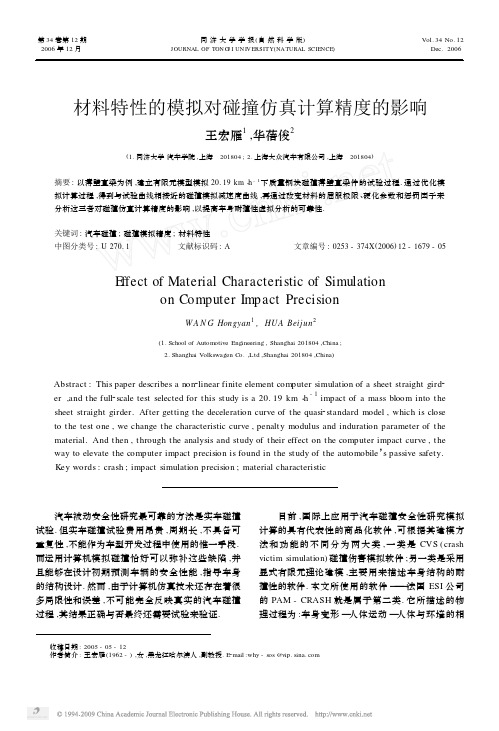
收稿日期:2005-05-12作者简介:王宏雁(1962-),女,黑龙江哈尔滨人,副教授.E 2mail :why -sos @材料特性的模拟对碰撞仿真计算精度的影响王宏雁1,华蓓俊2(1.同济大学汽车学院,上海 201804;2.上海大众汽车有限公司,上海 201804)摘要:以薄壁直梁为例,建立有限元模型模拟20.19km ・h -1下质量钢块碰撞薄壁直梁件的试验过程.通过优化模拟计算过程,得到与试验曲线相接近的碰撞模拟减速度曲线,再通过改变材料的屈服极限、硬化参数和惩罚因子来分析这三者对碰撞仿真计算精度的影响,以提高车身耐撞性虚拟分析的可靠性.关键词:汽车碰撞;碰撞模拟精度;材料特性中图分类号:U 270.1 文献标识码:A 文章编号:0253-374X (2006)12-1679-05E ffect of Material Characteristic of Simulationon Computer Impact PrecisionW A N G Hongyan 1,HUA Beij un2(1.School of Automotive Engineering ,Shanghai 201804,China ;2.Shanghai Volkswagen Co.,Ltd ,Shanghai 201804,China )Abstract :This paper describes a non 2linear finite element computer simulation of a sheet straight gird 2er ,and the full 2scale test selected for this study is a 20.19km ・h -1impact of a mass bloom into the sheet straight girder.After getting the deceleration curve of the quasi 2standard model ,which is close to the test one ,we change the characteristic curve ,penalty modulus and induration parameter of the material.And then ,through the analysis and study of their effect on the computer impact curve ,the way to elevate the computer impact precision is found in the study of the automobile ’s passive safety.Key words :crash ;impact simulation precision ;material characteristic 汽车被动安全性研究最可靠的方法是实车碰撞试验.但实车碰撞试验费用昂贵,周期长,不具备可重复性,不能作为车型开发过程中使用的惟一手段.而运用计算机模拟碰撞恰好可以弥补这些缺陷,并且能够在设计初期预测车辆的安全性能,指导车身的结构设计.然而,由于计算机仿真技术还存在着很多局限性和误差,不可能完全反映真实的汽车碰撞过程,其结果正确与否最终还需要试验来验证.目前,国际上应用于汽车碰撞安全性研究模拟计算的具有代表性的商品化软件,可根据其建模方法和功能的不同分为两大类,一类是CVS (crash victim simulation )碰撞伤害模拟软件;另一类是采用显式有限元理论建模,主要用来描述车身结构的耐撞性的软件.本文所使用的软件———法国ESI 公司的PAM -CRASH 就是属于第二类.它所描述的物理过程为:车身变形—人体运动—人体与环境的相第34卷第12期2006年12月同济大学学报(自然科学版)JOURNAL OF TON G J I UN IVERSITY (NATURAL SCIENCE )Vol.34No.12 Dec.2006互作用.汽车碰撞响应是个极其复杂的过程,涉及瞬时大变形,多种破坏模式,材料的塑性变形历史和应变率影响,结构屈曲和后屈曲行为,众多零件之间的相互作用等.因此,汽车碰撞模拟计算也是一个相当复杂的问题,它的计算精度受到许多因素的影响,其中比较重要的就是材料特性的模拟.国内外研究人员在这方面都做了许多探索和尝试,以提高模拟精度,但侧重点有所不同.笔者通过研究汽车用金属材料的特性,深入了解材料的加工工艺和加工热处理过程,在模拟计算过程中正确地定义材料的特性参数,分析碰撞变形后材料的变形吸能情况,对提高模拟计算精度具有非常重要的意义[1].1 碰撞模拟模型的建立汽车碰撞过程中,承载区内的众多零件都将参与碰撞变形,但保证汽车结构耐撞性的关键是能够控制主要吸能件的变形.在不同的车型中,虽然主要吸能件的几何形状有所不同,但普遍认为薄壁构件的塑性屈曲变形,可以较充分发挥材料的特性,耗散非常多的碰撞能量.但是在高速碰撞过程中,表现出的材料特性和力学机理目前尚未充分掌握,因此有必要从形状相对简单的薄壁直梁的研究开始.首先,采用质量为450kg 试验台车,对不同壁厚的薄壁构件(厚度为0.5~2.5mm )在不同速度(20~40km ・h -1)下做了大量的台车碰撞试验.然后,根据试验结果,完善有限元计算模型,确定实际碰撞条件下的材料性质及数值分析所需相关参数,考察各种材料特性因素对构件变形的影响,为有限元计算的准确性提供可靠的保证. 碰撞模拟计算模型采用了与实际试验完全相同的碰撞方式,即用具有一定质量的钢块以一定的速度撞向后端固接于固定壁的薄壁构件,使构件形成变形皱褶,并在一定的步长中计算并记录构件的减速度曲线.图1为构件截面尺寸和焊点布置情况.图2为模拟方法示意图,图中v 为碰撞速度.图1 构件截面尺寸和焊点布置(单位:mm)Fig.1 Section dimensionand spot w eldingpoint laying(unit :mm)图2 计算模拟方法示意图Fig.2 Diagramm atic dra wing of simulation method2 模拟计算结果与试验结果的比较2.1 碰撞后构件形状的对比从图3中可以看出,模拟计算的构件前部的褶皱情况和褶皱幅度基本符合试验时构件的变形情况.图3 模拟计算结果与试验结果的比较Fig.3 R esult comparison betw een simulation and test2.2 碰撞减速度曲线的比较实际试验中,薄壁直梁试件直接焊接在特制的钢板上,钢板通过螺栓与碰撞壁固定连接,在整个试验过程0.045s 的时间历程内,整个薄壁梁均有变形.而在模拟计算中,为了简化计算模型,将薄壁梁一端设置为刚体,以代替试验中的碰撞钢墙.这段薄壁梁在整个模拟计算时间历程内不会发生变形,因此在0.025s 后模拟条件与原试验条件不符,所以861 同济大学学报(自然科学版)第34卷 减速度曲线比较图只取前0.025s.有限元碰撞模拟计算量大,计算公式复杂,国际上一般要求模拟精度控制在10%以内.通过计算得知,碰撞减速度曲线(图4)中第一个波峰与试验曲线误差仅为7.147%,整个碰撞过程发生的时间与试验曲线基本相吻合.可以认为模拟计算达到了一定的精度,所建立的薄壁直梁构件有限元模型得到了验证.图4 计算与试验的碰撞减速度曲线Fig.4 Deceleration curve of simulation and test3 材料特性的分析和研究汽车减速度与纵向变形量的关系式为a m =v 2/2ΔL .其中:假设碰撞前汽车速度为v ,碰撞后速度降为零,轴向压缩量为ΔL ,碰撞过程中汽车以减速度a m 作匀减速运动.由公式可知,实际汽车的纵向压缩量与碰撞过程中汽车的平均减速度成反比,平均减速度也可作为汽车结构耐撞性的一个主要设计指标.因此,使用了减速度曲线图来对材料参数的定义结果进行研究.3.1 材料参数材料参数对于提高碰撞模拟的精度有极其重要的意义.材料的参数属性包括杨氏弹性模量、泊松比、厚度、密度、极限应力和应力应变曲线等,一般依据由材料的拉伸试验获得材料的应力应变曲线.在确定了一个钢材的型号之后,材料参数属性中的这些参数就都成了定值,不再变更,改变材料的屈服极限(图5),会对构件的吸能情况产生一定的影响.通过碰撞减速度曲线(图6)可以看出,由于材料屈服应力值下降,减速度的第一个峰值也降低了,第一个波峰所包含的面积(代表速度减小量)变小,即动能的变化量变小,构件的吸能情况变差.图5 变化屈服极限的材料的特性曲线图Fig.5 Material characteristics of changingyieldingstress图6 减小材料屈服极限的碰撞减速度比较图Fig.6 C rash deceleration comparison ofdiminishing yielding stress 通过多次相关模拟计算,得出:材料特性曲线中的截距,即屈服应力值直接影响着碰撞过程中减速度的第一个波峰的数值,且两者呈正相关的关系.因此,对普通钢材而言,当结构和变形模式一定时,材料屈服极限的增加可以提高结构的吸能能力.3.2 硬化参数材料除自身的参数属性外,还有一些力学性能,主要包括材料的弹性、屈服强度、抗拉强度、抗剪强度、硬度韧性和抗疲劳性等,材料的硬度参数即是表征材料力学性能中的硬度韧性一项.这些力学性能是影响冲压性能的主要因素,根据各种板料的性质不同,对外力(压力)的抵抗能力也不同.如果材料过软,则其允许变形量大;如果材料过硬,则容易使板料在外力的拉伸、弯曲过程中产生裂纹[2].可以通过一些工艺上的手段来实现对材料硬化参数的修改,改变构件的吸能情况.改变材料的硬化参数(图7),会对材料的吸能情况产生一定的影响.通过减速度曲线(图8)可以看出,材料的硬化参数变小,反映1861 第12期王宏雁,等:材料特性的模拟对碰撞仿真计算精度的影响在减速度曲线中即为:在0.025s 时间历程内,硬化参数改变后减速度波峰包含的面积(所表示的是速度减小量)比起原减速度曲线变小了,即构件的吸能情况在一定程度上变差.图7 变化硬化参数的材料特性曲线Fig.7 Material characteristics of changinghardnessparameter图8 减小硬化参数的碰撞减速度比较图Fig.8 C rash deceleration comparison ofdiminishing hardness parameter 通过多次相关模拟计算试验,再结合材料弹性模量的定义式E =σ/ε,可以得出:材料的硬化参数直接影响材料的硬化程度.一般而言,材料的弹性模量越大,弹性越好,吸能情况越好.3.3 惩罚因子根据弹塑性动力学理论,目前在PAM 2CRASH 软件中对碰撞模拟试验进行接触处理定义时,惩罚因子(也称刚度衰减系数)选取十分重要,它决定了接触表面之间虚拟“弹性弹簧”的刚度,而接触力等于接触刚度(K )与穿透量(δ)的乘积.对于壳单元,接触刚度K 按下式计算:K =f s A k/l式中:f s 为惩罚因子,缺省值为0.01;A 为单元面积;l 为最小对角线长度;k 为壳单元的体积模量.惩罚因子的定义直接影响着PAM -CRASH 中的计算模拟精度.而在PAM -CRASH 中,定义惩罚因子一直沿用的是经验值,数值为0.3[3].为了观察惩罚因子对构件耐撞性带来的作用,选取了左右相差幅度各为0.05的参数,图9即为修改了惩罚因子后与原减速度曲线的比较.图9 改变惩罚系数后的碰撞减速度比较图Fig.9 C rash Deceleration comparison of changingsliding interface scale 从图9中可以看出,惩罚因子的改变对减速度曲线的第一个波峰值没有丝毫的影响,这也进一步验证了上述对于第一个减速度波峰值只与屈服应力值有关的结论.同时发现,惩罚因子为0.25时,第二个减速度波峰值升高了,说明构件第二个变形阶段的吸能情况有所改善.从时间进程看,惩罚因子的改变对它没有影响.同样,若惩罚因子改变成0.35的减速度曲线,可以得出正好相反的结论.惩罚因子的改变对碰撞减速度的影响不是很大,但发现惩罚因子为0.25的曲线在第二个波峰上比原减速度曲线更接近实际试验曲线,使误差值从原来的19.04%下降到13.04%.4 参数综合优化材料的特性曲线对薄壁直梁构件减速度曲线第一个加载波峰值的影响最大,其主要原因是:材料特性中的屈服应力值直接影响构件减速度曲线的第一个加载波峰值.硬化参数可以改变材料的硬化特性,控制各个阶段的加载和卸载的能量的吸收情况.两者综合影响整个碰撞过程中加载和卸载的时间进程.惩罚因子的选取只是对减速度曲线的后两个波2861 同济大学学报(自然科学版)第34卷 峰的大小和形状有所影响.对普通钢材而言,当结构和变形模式一定时,材料屈服极限的增加可以提高结构的吸能能力;硬化参数方面,材料的弹性模量越大,弹性越好,吸能情况也越好;适当的减小惩罚因子有助于使模拟计算精度更高.另外通过与试验减速度曲线的数值分析比较,做出误差值见表1,以方便定量地观察材料特性各个方面对模拟计算精度的影响程度.表1 与实际试验减速度曲线相比较的误差T ab.1 E rror compared with test deceleration%波峰原模拟曲线仅减小材料屈服极限仅减小材料硬化参数f s=0.25f s=0.35第一个波峰值7.147 4.01 3.37第二个波峰值19.0413.0421.53 这样可以根据上述分析,综合修改三个材料参数的设定,得出优化后的模拟计算减速度曲线(图10).可见,无论是曲线走向还是峰值大小更加接近试验结果,使整个模拟计算精度提高了2%.图10 修正的减速度比较结果图Fig.10 R esult of deceleration comparisonafter amending5 结语以薄壁直梁为例,本文建立有限元模型模拟20.19km・h-1下质量钢块碰撞薄壁直梁件的试验过程.通过改变材料的屈服极限、硬化参数和惩罚因子来分析这三者对碰撞仿真计算精度的影响,得出了综合优化曲线,以提高车身耐撞性虚拟分析的可靠性.参考文献:[1] 雷正保,钟志华.结构碰撞分析中的动态显示有限元方法及应用[J].振动与冲击,1999,18(3):71. L EI Zhengbao,ZHON G Zhihua.Dynamic explicit FEM of struc2 tural impact response problem and its applications[J].Journal of Vibration and Shock,1999,18(3):71.[2] 库克R D.有限元分析的概念和应用[M].北京:科学出版社,1981. Cook R D.Concepts and applications of finite element analyse [M].Beijing:Science Prss,1981.[3] 洪善桃,高卫民,王宏雁.有限元结构分析与计算[M].上海:同济大学出版社,2003. HON G Shantao,GAO Weimin,WAN G Hongyan.Structure analy2 sis and calculation of FEM[M].Shanghai:Tongji University Press,2003.(编辑:曲俊延)更 正 本刊2006年第10期《基于标准正交基的随机过程展开法》一文中,第1281页式(17)中的X(T),应更正为X(t);第1282页中K U(x1,x2,ω)=exp-ω100x1-x2,应更正为K U(x1,x2,ω)=exp-ω1000x1-x2.特此说明!3861 第12期王宏雁,等:材料特性的模拟对碰撞仿真计算精度的影响 。
MS-6000 ZINC AND ZINC-IRON ALLOY COATED SHEET STEEL
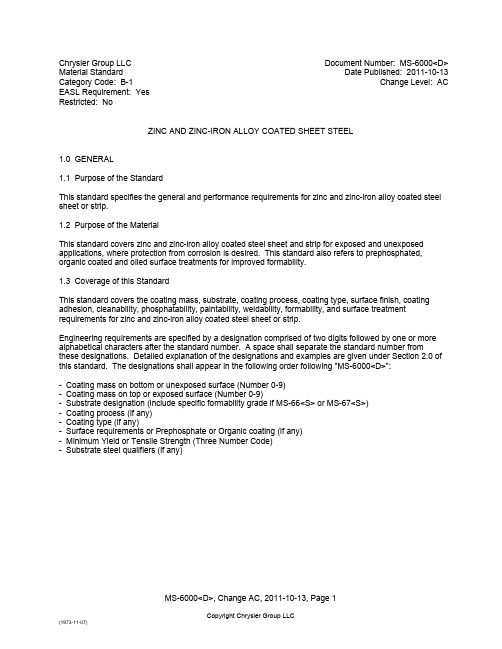
Chrysler Group LLC Document Number: MS-6000<D> Material Standard Date Published: 2011-10-13 Category Code: B-1 Change Level: AC EASL Requirement: YesRestricted: NoZINC AND ZINC-IRON ALLOY COATED SHEET STEEL1.0 GENERAL1.1 Purpose of the StandardThis standard specifies the general and performance requirements for zinc and zinc-iron alloy coated steel sheet or strip.1.2 Purpose of the MaterialThis standard covers zinc and zinc-iron alloy coated steel sheet and strip for exposed and unexposed applications, where protection from corrosion is desired. This standard also refers to prephosphated, organic coated and oiled surface treatments for improved formability.1.3 Coverage of this StandardThis standard covers the coating mass, substrate, coating process, coating type, surface finish, coating adhesion, cleanability, phosphatability, paintability, weldability, formability, and surface treatment requirements for zinc and zinc-iron alloy coated steel sheet or strip.Engineering requirements are specified by a designation comprised of two digits followed by one or more alphabetical characters after the standard number. A space shall separate the standard number from these designations. Detailed explanation of the designations and examples are given under Section 2.0 of this standard. The designations shall appear in the following order following "MS-6000<D>":- Coating mass on bottom or unexposed surface (Number 0-9)- Coating mass on top or exposed surface (Number 0-9)- Substrate designation (include specific formability grade if MS-66<S> or MS-67<S>)- Coating process (if any)- Coating type (if any)- Surface requirements or Prephosphate or Organic coating (if any)- Minimum Yield or Tensile Strength (Three Number Code)- Substrate steel qualifiers (if any)1.4 Designations1.4.1 Alphabetical and Numeric DesignationsTABLE 1: SINGLE SIDE COATING MASS DESIGNATIONSCOATING MASS DESIGNATIONCoating Weight ( g/m 2 )Minimum Maximum0 0 0 1 20 50 2 30 60 4 45 75 5 60 90 6 90 130 7 100 140 8 150 200 9 75 100TABLE 2: ALPHABETICAL DESIGNATIONS***Substrate No Code MS-66<S> or MS-67<S> substrate (Refer to Section 2.2.1) Substrate Code V High Strength (MS-264<S> substrate steel (Refer to Section 2.2.2) Substrate Code W Medium strength substrate steel (Refer to Section 2.2.3) Coating No Code Pure Zinc coating (Refer to Section 2.3.1) Coating Code P Electrolytic coating process (Refer to Section 2.3.2) Coating Code A Zinc-iron alloy coating (Refer to Section 2.3.3)Coating Code COrganic coating on both sides of the sheet steel (exposed & unexposedside) (Refer to Section 4.5)Coating Code J Organic coating on the bottom side of the sheet steel (Refer to Section 4.5)FIGURE 1: FIGURE SHOWING THE ORDER IN WHICH THE VARIOUS CODES AND QUALIFIERS ARE ARRANGED TO SPECIFY ENGINEERING REQUIREMENTSSurface Finish (see Table 2)TABLE 2: ALPHABETICAL DESIGNATIONS***Coating Code N Prephosphated & Oiled Unexposed Quality (Refer to Section 4.4) Coating Code R Prephosphated & Oiled Exposed Quality (Refer to Section 4.4)Coating Code L Electro-galvanized zinc coated laminate (MS-8378) material (Refer to Section 2.2.2.9)Surface No Code Unexposed surface finish and appearance (Refer to Section 2.4.1)Surface Code ECritical exposed surface finish and appearance (Refer to Section 2.4.2)TABLE 3: ALPHABETICAL SUBSTRATE QUALIFIERSY 1 Y 2S - Structural Steel (Refer to Section 2.2.2.1)X - High Strength Low Alloy Steel (Refer to Section 2.2.2.2) D - Dual Phase substrate steel (Refer to Section 2.2.2.3) P - Partial Martensitic Steel (Refer to Section 2.2.2.4) T - TRIP substrate steel (Refer to Section 2.2.2.5)H -Bake Hardenable (MS-264<S>) substrate steel (Refer to Section 2.2.2.6)- TTensile strength (in MPa) based call-out used with qualifiers D and T (Refer to Sections2.2.2.3, 2.2.2.4 and 2.2.2.5)- F Fine grain refinement deoxidation practice with inclusion control (Refer to Section 2.2.2.7) - K Fine grain refinement deoxidation practice (Refer to Section 2.2.2.8)1.5 Additional Manufacturing RequirementsAdditional manufacturing requirements may also be specified by the addition of certain designationsdescribed herein to the Chrysler Stamping Division Metal Parts Specification sheet (if applicable), the user plant purchase requisition or release, and on the purchase order. See Section 4.4 of this revision.2.0 MATERIAL CHARACTERISTICS2.1 Coating Mass<D>The mass of the zinc or zinc-iron alloy coating on each side of the sheet shall be designated by a single numerical digit: either 0, 1, 2, 4, 5, 6, 7, 8, or 9. In the case of critical exposed quality steel, the second digit shall represent the coating mass on the exposed surface. The coating mass designated by each digit shall meet the requirements shown in Table 1.The coating mass shall be determined using the single spot method, in accordance with ASTM standard A-90, current revision, with the exception that the coating weight measurement shall be performed on each side of the sheet separately.For coating line process control, in-line X-ray fluorescence coating mass measurement per ASTM Standard A-754, latest revision is acceptable, provided proper calibration with the weigh-strip-weigh method (ASTM A-90) is maintained. However, in the case of a dispute, the weigh-strip-weigh method shall be the referee method.2.2 Substrate Requirements***Either none or one of the letter codes described below shall appear following the coating weight designations to specify substrate steel requirements.The 0.010 weight % maximum tin content requirement for exposed and unexposed, cold-rolled steel specified in MS-67<S> shall not apply to steel that is subsequently zinc or zinc-iron alloy coated per MS-6000<D>.2.2.1 No Code***If no letter code designating the substrate appears, the substrate steel shall conform to the requirements of mild steel specifications MS-66<S> or MS-67<S>. In this case appropriate formability code shall be added at the end of the specification.MS-66<S>, Low carbon Hot Rolled Steel - Sheet and Strip, includes three grades HR11, HR12, andHR13. Similarly, MS-67<S>, Low carbon Cold Rolled Steel - Sheet and Strip, includes five grades CR01, CR02, CR04, CR05, and CR06. See examples provided in section 2.5.2.2.2 Code VWhen Code V is specified, the substrate steel shall conform to the requirements of MS-264<S> "High Strength and Structural Quality Steels - Sheet, Strip, Plate, Flat Bar and Welded Mechanical Tubing", as is appropriate for the application and as agreed to between the supplier and Chrysler Group LLC. The minimum yield/tensile strengths of the steel shall be specified as described in MS-264<S> with a three digit code, to be placed at the end of the MS 6000<D> callout following all other coating mass and material characteristic codes (see example in Section 2.5). The mechanical properties of the as-received material shall meet the requirements corresponding to the specified three-digit code as described in MS-264<S>, latest revision. If Code V is specified and the yield/tensile strengths code does not appear, the user shall inquire to the Chrysler Engineering department responsible for release of the part in question to obtain the intended strength requirement.2.2.2.1 Qualifier SStructural steel. Refer to MS-264<S>, latest revision2.2.2.2 Qualifier XHigh strength low alloy steel. Refer to MS-264<S>, latest revision.2.2.2.3 Qualifier D***Dual Phase Steel.Strength call-out for dual phase steels (i.e. when Code “D” is specified) will be in MPa. The minimum tensile strength of the material shall be specified in MPa by a three digit numerical (XXX) code designating the strength level designation followed by two letter codes (DT) to further define the type of the steel, "MS-6000-44VA-XXXDT". Refer to MS-264<S>, latest revision.2.2.2.4 Qualifier PPartial Martensitic SteelSimilar to Dual Phase call-out, tensile strength is specified in MPa followed by two letter code (PT).2.2.2.5 Qualifier TTRIP (transformation induced plasticity) steel.Similar to Dual Phase call-out, tensile strength is specified in MPa followed by two letter code (TT).2.2.2.6 Qualifier HBake hardenable substrate steel. Refer to MS-264<S>, latest revision.2.2.2.7 Qualifier FFine grain refinement deoxidation practice with inclusion control. Refer to MS-264<S>, latest revision. 2.2.2.8 Qualifier KFine grain refinement deoxidation practice. Refer to MS-264<S>, latest revision.2.2.2.9 Qualifier LElectrogalvanized zinc coated laminate material (Refer to MS-8378).2.2.3 Code WWhen Code W is specified, the substrate steel shall be of a medium strength, commonly rephosphorized grade steel. This material is characterized by having good formability and high work hardenability, providing improved strength in the formed part for structural strength or dent resistance. The material typically achieves this characteristic through the addition of substitutional strengthening elements, such as phosphorus. The yield strength of the steel shall be specified as a three-digit code, to be placed at the end of the MS-6000<D> callout following all other coating mass and material characteristic designations. The codes to be used for this grade and the corresponding mechanical properties of the as-received material shall meet the requirements described in Table 4.TABLE 4: REQUIREMENTS FOR THE MECHANICAL PROPERTIES OF AS RECEIVED MATERIALYIELD STRENGTHCODE PREFERRED YIELDSTRENGTHMPA (KSI)MINIMUM TENSILESTRENGTHMPA (KSI)MINIMUM N-VALUE(CALCULATEDBETWEEN 10 & 20%)W 025 180-230 (26-33) 345 (50) 0.20W 030 215-260 (31-38) 380 (55) 0.182.3 Coating ProcessUnless specified by one of the following letter codes, the zinc or zinc-iron alloy coated sheet or strip may be produced by either the hot dip (HDG or HDGA) or electrogalvanize (EG or EGA) methods defined in Section 6.0.2.3.1 No CodeIf no letter code designating the coating process appears, the coating shall be of substantially pure zinc (either HDG or EG) as defined in Section 6.0 of this standard.2.3.2 Code PWhen Code P is specified the sheet or strip shall be produced by the electrolytic method (EG for zinc coatings and EGA for zinc-iron alloy coatings) as defined in Section 6.0 of this standard.2.3.3 Code AWhen Code A is specified, the sheet or strip shall have a zinc-iron alloy coating. The coating can be produced by either the hot-dip (GA) or electro zinc-iron alloy (EGA) process, as defined in Section 6.0 of this standard.2.3.4 Bulk Iron Content***The bulk iron content of unexposed zinc-iron alloy coatings produced by either the hot-dip (GA) or electrogalvanized (EGA) process shall be 7 to 16 weight %.The bulk iron content of critical exposed (Codes E), electrogalvanized (EGA) zinc-iron alloy coatings shall be 10 to 20 weight %.The bulk iron content of critical exposed (Codes E), hot-dip (GA) zinc-iron alloy coatings shall be 7 to 14 weight %.2.4 Surface FinishAll hot-dip galvanized sheet or strip (HDG) shall be produced with "minimized spangle" which is defined as spangle size not exceeding 6.25 mm (0.25 in.) in diameter with no relief. All zinc and zinc-iron alloy coatings shall be continuous and free of voids or bare spots.2.4.1 No CodeUnexposed surface finish and appearance.2.4.2 Code E (Exposed Quality)***When Code E is specified, the coated surface quality shall be suitable for critically exposed (Class 1) surfaces and shall be free from any surface defect or discontinuity, which will detract from subsequent surface inspection or the final painted appearance of the part. The substrate steel shall not exhibit yield point elongation (Lüders bands or stretcher strain). Zinc-iron alloy coatings shall be free of un-alloyed zinc. The coated sheet shall meet the surface texture requirements for critical exposed applications as shown in Figures 2 and 3.Surface roughness and peak count shall be measured in accordance with Chrysler Process Standard PS-899, with a 0.8 mm (0.030 inch) cut-off and a 25.4 mm (1 inch) stroke. Peak count measurements are to be made with a 12.5x10-4mm (50x10-6 in) threshold.2.5 Examples***MS-6000 44A-CR04 - Coating weight 45-75 g/m2 on both sides, MS-67<S>CR04 substrate steel (cold rolled mild steel grade CR04), both surfaces zinc-iron alloy coated, and unexposed surface requirements.MS-6000 44A-HR12 - Coating weight 45-75 g/m2 on both sides, MS-66<S>HR12 substrate steel (hot rolled mild steel grade HR12), both surfaces zinc-iron alloy coated, and unexposed surface requirements.MS-6000 44AE-CR05 - Coating weight 45-75 g/m2 on both sides, MS-67<S>CR05 substrate steel, both surfaces zinc-iron alloy coated, and critically exposed surface requirements.MS-6000 44VA -050XF - Coating weight 45-75 g/m2 on both sides, MS-264<S> substrate steel, both surfaces zinc-iron alloy coated, unexposed surface requirements, minimum yield strength 340 MPa (50 ksi), and High Strength Low Alloy Steel (with fine grain refinement, de-oxidation, and inclusion shape control).MS-6000 55PE-CR05 - Coating weight 60-90 g/m2 on both sides, MS-67<S>CR05 substrate steel, both surfaces electrogalvanized (EG) coated, and critical exposed surface requirements.MS-6000 66V-080XK - Coating weight 90-140 g/m2 on both sides, MS-264<S> substrate steel, both surfaces assumed to be free zinc coated, unexposed surface requirements, minimum yield strength 550 MPa (80 ksi), and High Strength Low Alloy Steel (fine grain refinement de-oxidation).MS-6000 44WAE-025 - Coating weight 45-75 g/m2 on both sides, Medium strength substrate steel, both surfaces zinc-iron alloy coated, critical exposed surface requirements, 345 MPa (50 ksi) minimum tensile strength and preferred yield strength ranging between 180-230 MPa (26-33 ksi).MS-6000 44VA-590DT - Coating weight 45-75 g/m2 on both sides, MS-264<S> substrate steel, both surfaces assumed to be zinc-iron alloy coated, unexposed surface requirements, minimum tensile strength 590 MPa, and Dual Phase Steel.3.0 PERFORMANCE REQUIREMENTS OF THE MATERIAL3.1 Coating Adhesion3.1.1 Zinc and Zinc-Iron Alloy Coated Sheet ( t ≤ 1 mm, and YS ≤ 40 ksi, where, t is the thickness and YS is the yield strength of the material)Each side of the coated sheet or strip 1 mm or less in thickness shall be tested according to Chrysler Laboratory Procedure LP-461H-120. Each side shall conform to a Double Olsen rating of 3.5 or less across the coil width. This requirement shall apply to exposed quality (Code E), semi-exposed quality (Code F), and unexposed quality sheet.3.1.2 Zinc And Zinc-Iron Alloy Coated Sheet (t ≥1 mm, or YS ≥ 040 ksi)3.1.2.1 Free Zinc CoatingsEach side of the zinc-coated sheet or strip shall conform to the bend test requirements of ASTM Standard Specification A-653(M), Coating Properties/Coating Bend Test section.3.1.2.2 Zinc-Iron Alloy CoatingsEach side of the zinc-iron alloy coated sheet or strip shall be capable of being bent through 90 degrees and straightened without any flaking or loss of adhesion to the substrate on the inside radius of the bend. Moderate to heavy powdering without loss of adhesion to the substrate is acceptable. The ratio of the inside bend diameter to the thickness of the specimen shall be in accordance with ASTM Standard Specification A-653(M), Table 6 (latest revision).Other coating adhesion test data may be acceptable for compliance. Contact the Body Materials Engineering Department, Vehicle Engineering, Chrysler Group LLC.3.2 Cleanability, Phosphatability and PaintabilityZinc and zinc-iron alloy coated sheet shall conform to the cleanability and phosphatability requirements of PS-7449, "Chemical Surface Treatment - Steel, Aluminum, and Galvanized Steel Assemblies and Passenger Car Bodies - Full Immersion". It shall also conform to the cyclic corrosion and adhesion requirements of PS-6634, "Painting, Passenger Car Vehicle Bodies, Cathodic Electroprimer". Exposed quality sheet (Code E) shall be free from "aspect" (directional) or "flow" pattern after cathodic E-coat.3.3 WeldabilityZinc and zinc-iron alloy coated sheet shall meet the resistance spot welding requirements specified by the Chrysler Laboratory Procedure LP-461K-170 or as specified by Body Materials Welding.4.0 ADDITIONAL / MANUFACTURING REQUIREMENTS4.1 Manufacturing CharacteristicsThis section describes the manufacturing characteristics of the material. These requirements may be specified at the discretion of the user plant. It is not required that they appear on the engineering drawing or computer aided design file, but they may be specified there as well. If required, these characteristics shall be specified on the Chrysler Stamping Division Metal Parts Specification sheet (if applicable), the user plant purchase requisition or release, and on the purchase order. Zinc and zinc-iron alloy coated sheet steel shall be purchased for a particular part specified by part number and name on the Chrysler Stamping Division Metal Parts Specification sheet (if applicable), the user plant purchase requisition or release, on the purchase order and shall be suitable in surface, temper, and drawing qualities for that part. Any necessary "extras" shall also be specified on the purchase order, or be negotiated between the supplier and the user.4.2 Formability***The quality level of steel supplied to fabricate a specific component shall be negotiated between the manufacturing activity and the steel supplier. Acceptance of subsequent orders by the steel supplier for a given component at the agreed upon quality level implies that all steel supplied will be of a comparable quality level and will form that part satisfactorily as defined by the manufacturing activity. Chrysler Group LLC materials engineering may, at its option and in agreement with the steel supplier, compile a list of property requirements such as mechanical properties, forming characteristics and surface texture, for each specific part. This list will be a mandatory extension of these specifications. For those parts where specific forming / mechanical property windows have been established for defect free stamping, property conformance is required. Material suppliers may direct their inquiries on these windows of properties to the Plant Metallurgist or Plant Sheet Metal Contact Engineer at the Chrysler user plant.4.3 Mill OilUnless specified otherwise, the finished zinc or zinc-iron alloy coated sheet or strip shall be coated on all sides with a Chrysler approved mill oil per MS-9680 "Mill Oils and Edge Sealers - Sheet Metal", prior to shipment and delivery.4.4 Prephosphated and OiledZinc and zinc-iron alloy coated sheet and strip can be coated with a zinc phosphate coating which, in combination with mill oil, provides improved formability. The material and performance requirements for this coating are described in Chrysler PS-9645, "Prephosphated Steel - Chemical Surface Treatment of Zinc & Zinc-Iron Alloy Coated Sheet/Strip Steels".If required, prephosphated and oiled steel sheet shall be specified by the one of the following codes being appended to the material standard for the part. These designations may be added to the computer aided design (CAD) file for the part by the releasing design group, or they may be added to the Chrysler Stamping Division Metal Parts Specification sheet (if applicable) at the discretion of the user plant without being added to the CAD file. The callout must appear on the Chrysler Stamping Division Metal Parts Specification sheet (if applicable), the user plant purchase requisition or release, and on the purchase order.Code N - Prephosphated and oiled unexposed surface finish and appearanceCode R - Prephosphated and oiled critical exposed surface finish and appearance. Material shall meet all requirements of Code E - Exposed Quality Sheet (see Section 2.4.2).These codes shall be placed following the coating weight and substrate callouts, as shown in the example in Figure 1. If Code R is applied to the specification, it shall be substituted in place of Code E.The phosphate treatment shall be applied by a Chrysler approved phosphating line listed in the ApprovedSource List (Table 16).Prephosphated and oiled products shall meet the performance requirements specified in Section 3.0 of this standard.4.5 Organic CoatingsElectrolytically zinc coated steel and flat strip can be further coated with an organic coating for improved corrosion performance, especially in lap joint areas where e-coat coverage is poor or minimal. The releasing design group will add these designations to the CAD file for the part.Code “C” – Organic coating on both sides of steel sheet (exposed side and unexposed side)Code “J” – Organic coating on bottom side of steel sheet (unexposed side)Example – MS-6000-55PE(C or J)The organic coating shall be applied by a Chrysler approved coating line listed in the Approved Source List. (Table 17)4.6 Dimensional RequirementsProducts supplied to MS-6000<D> shall meet the requirements specified in PS-5570, "Sheet Steel in Coils and Cut Lengths - Thickness, Width, and Length Measurement" for zinc and zinc-alloy coated steel sheet and strip.5.0 QUALITYRefer to CS-9801 for general quality requirements.6.0 DEFINITIONS/ABBREVIATIONS/ACRONYMSZinc Coating: Coatings of substantially pure zinc.Hot Dip Galvanized (HDG): A coating produced by immersion of the steel in a bath of substantially pure molten zinc. The presence of other elements in the coating, e.g. tin or aluminum, is typical. Electrogalvanized (EG): A coating produced by electrolytic deposition of pure zinc on sheet steel.Zinc-Iron Alloy Coating: Coatings of zinc alloyed with nominally 10-15% iron.Galvannealed (GA): A coating produced by thermal diffusion of zinc into the sheet steel surface after hot-dip, electrolytic, or vapor deposition coating.Electrolytic zinc-iron alloy (EGA): A zinc-iron alloy coating produced by the electrolytic co-deposition of zinc and iron on sheet steel.Prephosphated and Oiled Surface Treatment: A conversion coating of zinc phosphate applied to the surface of zinc or zinc-iron alloy coated steel sheet or strip in coil form with a mill oil applied prior to use. This treatment can be applied to the sheet or strip by the following means:Conventional Process: Zinc phosphate treatment is applied by immersion of the sheet or strip in the phosphating solution or by spraying the phosphating solution onto the sheet or strip, followed by rinsing and drying.Dry-In-Place Process: Zinc phosphate treatment or Organic coating is applied to the sheet or strip with a roller using a chem-coater, squeegee or paint coater system, followed directly by drying (no rinsing is involved).In-Line Process: Either Conventional or Dry-In-Place zinc phosphate treatment or organic coating is applied at the end of the galvanizing line.Off-Line Process: Either Conventional or Dry-In-Place zinc phosphate treatment or organic coating is applied on an installation separate from the galvanizing operation.Spangle: The characteristic crystalline form in which a hot dipped zinc coating solidifies on steel strip.7.0 CONTROLChanges to the production process are not allowed without the prior notification and approval of Chrysler Group LLC.8.0 GENERAL INFORMATIONThree asterisks “***” after the section/paragraph header denotes single or multiple technical changes to the section/paragraph. Specific technical changes within a section, subsection, table, or figure may be highlighted in yellow.Certain important information relative to this standard has been included in separate standards. To assure the processes submitted meet all of Chrysler requirements, it is mandatory that the requirements in the following standards be met.CS-9800 - Application of this standard, the subscription service, and approved sourcesCS-9003 - Regulated substances and recyclabilityWithin Engineering Standards, the Regulatory (Government-mandated) requirements are designated by<S> and <E> which correspond to Safety and Emission Shields respectively. When applicable, the Chrysler mandated requirements are designated by <D> which correspond to the Diamond symbol and by <A> for Appearance related objectives, respectively.For specific information on this document, please refer to the contact person shown in the "Publication Information" Section of this document. For general information on obtaining Engineering Standards and Laboratory Procedures, see CS-9800 or contact the Engineering Standards Department atengstds@.9.0 REFERENCESChrysler Standards ASTMStandardsISOStandardsSAEStandardsFederalStandardsCS-9003 A-90CS-9800 A-653(M)CS-9801 A-754 LP-461H-120LP-461K-170MS-66<S>MS-67<S>MS-264<S>Chrysler Standards ASTMStandardsISOStandardsSAEStandardsFederalStandardsMS-6000<D>MS-8378MS-9680PS-899PS-5570PS-6634PS-7449PS-9645PS-7300<D>Quality and Reliability DocumentsOther Documents10.0 ENGINEERING APPROVED SOURCE LIST ***TABLE 5: ENGINEERING APPROVED SOURCE LISTHOT DIP ZINC (HDGI) AND HOT DIP ZINC-IRON ALLOY (HDGA) COATEDCOLD ROLLED MILD STEELSMaterials covered by this standard shall only be purchased from the source(s) listed in this table COMPANY SUBSTRATE/COATING PLANT HDGI HDGACR01CR02CR04CR05CR06CR01 CR02 CR04 CR05CR06AK Steel AshlandWorks X X X-E X-E X-E Middletown/Rockport X X X X X X X X-E X-E X-EArcelorMittal ArcelorMitalEurope/DSG X XX-EX-EX-E Dofasco/Hamilton X X X X X X X X X X Dofasco/DJG X X X X X X X X-E X-E X-E Dofasco/DSG X X X X X X X X-E X-E X-E IndianaHarbor/IH#5 X X X X X X X X X X Indiana Harbor/ I/N Kote X X X-E X-E X-E Burns Harbor/ BH X X X X X X X X-E X-E X-E Burns Harbor/ Columbus X X X-E X-E X-E Cleveland/Columbus X X X X IndianaHarbor/Columbus X X X X IndianaHarbor/IH#2 X X X X Cleveland/Cleveland X X X XBao Steel BNA # 1 X X X-E X-EChina Steel Corporation Kaohsiung #2,TaiwanX X X XHylsamex Hylsa/Galvak X X X X APM/Galvak X X X XJFE Chiba#3 X XX-EX-EX-E Chiba#2 X XX-EX-EX-E Fukuyama#1 X XX-EX-EX-E Fukuyama#2 X XX-EX-EX-ENippon Steel Nagoya#1 X X X X X X X X-E X-E X-E Nagoya#2 X XX-EX-EX-E Nagoya#4,#5 X XX-EX-EX-E Yawata X XX-EX-EX-EPOSCO KwangyangWorks/#4CGL X XX-EX-EX-E Kwangyang/Altamira X X X X X X X XHeidtman-SDI Butler X X Natl. Galv. Inc. X XSeverstal NA Dearborn/ Spartan X X X XThyssenKrupp Steel Bochum # 7 X X X X X X X X-E X-E X-ETABLE 5: ENGINEERING APPROVED SOURCE LISTHOT DIP ZINC (HDGI) AND HOT DIP ZINC-IRON ALLOY (HDGA) COATEDCOLD ROLLED MILD STEELSMaterials covered by this standard shall only be purchased from the source(s) listed in this table COMPANY SUBSTRATE/COATING PLANT HDGI HDGACR01CR02CR04CR05CR06CR01 CR02 CR04 CR05CR06 ANSC/TAGAL X XX-EX-EX-EU S Steel Hilton Works/ Hilton Works X X X XHiltonWorks/Z-line X X X X X X X X-E X-E Hilton Works/ Winner Steel X X X XFairless X X X XGary Works/ Protec # 1 X X X X X X X X-E X-E X-E Gary Works/ Protec # 2 X X X X X X X X-E X-E X-E Gary Works/ Protec # 1 X X X X X X X X-E X-E X-E Gary Works/ Protec # 2 X X X X X X X X-E X-E X-E GaryWorks/Midwest X X X X X X X X-E X-E X-E GreatLakes/Midwest X X X X X X X X-E X-E X-E Great Lakes/ CGL # 1 X X X X X X X X-E X-E X-EWeirtonSteel Weirton X X X XTABLE 6: ENGINEERING APPROVED SOURCE LISTHOT DIP ZINC (HDGI) AND HOT DIP ZINC-IRON ALLOY (HDGA) COATEDHOT ROLLED MILD STEELSMaterials covered by this standard shall only be purchased from the source(s) listed in this tableCOMPANY SUBSTRATE/COATING PLANT HDGI HDGAHR11 HR12 HR13 HR11 HR12 HR13 AKSteel AshlandWorksArcelorMittal Dofasco/Hamilton X X X IndianaHarborCGL#5IndianaHarbor/I/NKoteBurnsHarbor/BHBurns Harbor/ ColumbusIndianaHarbor/ColumbusIndiana Harbor CGL#2 X XPOSCO KwangyangWorks/#4CGL Kwangyang/AltamiraHeidtman-SDI Butler。
- 1、下载文档前请自行甄别文档内容的完整性,平台不提供额外的编辑、内容补充、找答案等附加服务。
- 2、"仅部分预览"的文档,不可在线预览部分如存在完整性等问题,可反馈申请退款(可完整预览的文档不适用该条件!)。
- 3、如文档侵犯您的权益,请联系客服反馈,我们会尽快为您处理(人工客服工作时间:9:00-18:30)。
触摸屏
一、异方性导电胶(ACF)
特点:具有单向导电和粘合固定功能(需 用冰柜冷藏)。 组成:导电胶的组成主要分为导电粒子 (导电填料)和绝缘胶材(粘料) 两部分。
触摸屏
导电原理
导电胶的导电机理在于导电性填料之间的接触, 这种填料与填料的相互接触是在粘料固化干燥 后形成的,在粘料固化干燥前,粘料和溶剂中 的导电性填料是分别独立存在的,相互间不呈 现连续接触,故处于绝缘状态。经加热及加压 一段时间后,由于溶剂蒸发和粘料固化,导电 填料相互间连结成链锁状,最后形成垂直导通、 横向绝缘的稳定结构。
触摸屏
结束语
以上所涉及的材料是目前整个电阻式触摸屏行 业主要使用的材料。当然,随着科技不断的进 步,材料也会不断地更新,而我们的产品也会 不断地引用新材料。因此,希望各位能够自觉 地持续地去了解和掌握各种材料的特性,以便 我们公司能够做出更好、更先进的产品。
触摸屏
谢 谢 大 家!
触摸屏
材质特性知识
主讲人:Phoenix.zou
前言
材料是生产的基本条件,材料的材质直接 影响着生产工艺和产品的最终质量。那么,我 们该如何去确定一种材料的材质呢? 答案就是通过材料的特性去判定材料的材 质。因此,作为一名工程技术人员,就必须清 楚地了解各种材料的特性,才能持续地改进生 产技术,从而提高生产的效率和产品的质量。
触摸屏
七、粘接材料
水性胶水:属于压敏胶(俗称不干胶),可反 复多次使用,但不耐高温。 油性胶水:耐高温,但丝印时容易拉丝,会污 染到产品的可视区域。 双面胶:具有耐高温和耐高湿的特性,但对银 线比较细的产品不好操作。
触摸屏
八、PET保护膜
PET保护膜:具有高清晰、高透光、防刮 伤、防磨损和静电吸附等性能,影响PET保护 膜材质的主要参数有外观、雾度、透光度、硬 度和附着力等。
触摸屏
导电胶不良现象及相关解决技术
触摸屏
二、氧化铟锡(ITO)
氧化铟锡(即Indium Tin Oxide,简称ITO)材 料是一种N型(即立方型)半导体材料,具有 高导电率、高透光率、高机械硬度和化学稳定 性等特点。它可以切断对人体有害的电子辐射, 紫外线及远红外线。因此,喷涂在玻璃,塑料 及电子显示屏上后,在增强导电性和透明性的 同时切断对人体有害的电子辐射及紫外、红外。
触摸屏
ITO回路电阻理论值的计算方法
三、UV油墨
UV油墨是近年来迅速发展的一种环保性油 墨,与传统的溶剂型油墨相比,UV油墨有光 泽度好、立体感强、无有害溶剂挥发等优点, 特别是在油墨的干燥方面,UV光固油墨在紫 外光照射下即可瞬间固化,避免了传统的溶剂 型油墨干燥周期长,占地面积大等缺点,大大 提高了工作效率和质量。
触摸屏
五、可剥油墨
可剥油墨是专为触摸屏开发的保护性油墨,是一 种具有表面保护作用的材料,可通过丝网印刷在PET、 ITO膜和ITO玻璃上,起到防止材料在生产过程中受到 污染或划伤的作用。在触摸屏上、下两层粘合之前, 可用粘棒工具揭掉。 可剥油墨需要注意的主要参数有:固化条件,印 刷网目,印刷厚度,外观,粘度和可耐温度等。 注意:不合格的可剥油墨剥离之后会残留在材料 表面或者污染材料,烘烤时,会产生油烟等现象,对 烘箱产生污染。
触摸屏
六、光学胶(OCA)
组成:光学胶由树脂、固化剂和改性剂组成。 光学胶详细描述: 【规格】电阻屏使用: 中间压粘合层厚度是175um~300um; 电容屏使用:50um~100um; 【特征用途】 1.无色、高洁净度、高透明度,几乎不影响萤幕的的辉度及色调 Colorless, high purity, high transparency, almost no impact to the luminance and color tone of screen 2.耐UV光,不黄变 UV light resistant, not yellowing. 3.可配合设计,调整光学胶的外观形状 Can adjust the contour to meet customer’s design. 4.本身自有黏著的特性,在室温下,也可以贴合 Inherent adhesion, can be bonded in room temperature. 5.高黏著性。在贴合时,有优良的气泡消散性、应力缓和性,被著面的段差 吸收性 High adhesive strength with good bubble-dissipation capability, good stress relaxation and gap absorption capability
触摸屏
导电胶导电原理图
触摸屏
注意:
在导电胶中导电粒子是扮演垂直导通的关键角色,胶 材中导电粒子数目越多或导电粒子的体积越大,垂直 方向的接触电阻越小,导通效果也就越好。但是,过 多或过大的导电粒子可能会在压合的过程中,使横向 的电极凸块间彼此导通,而造成横向导通的短路现象。 还有,当温度与压力过大时,会致使导电粒子破碎, 造成导电不良。 针对此现象,我们要注意来料的检验与丝印时相关设 备的调节,例如丝印的厚度,热压的压力与温度等等。
触摸屏
ITO基材
因为ITO产品的用途比较特殊,所以对基材的透光 率、雾度、热收缩率和表面附着力要求都比较高,应 用于ITO产业的基材主要有浮法玻璃、有机玻璃和塑 胶薄膜等工业级材料。 目前ITO主要是通过真空磁控溅射技术镀到基材上 的。磁控溅射技术是利用磁场控制辉光放电产生的等 离子体来轰击出靶材表面的粒子并使其沉积到基片表 面的一种技术。
触摸屏
ITO的光电性能
ITO具有优异的光电性能:对可见光透过 率可达85%以上,低电阻率(10-3Ω·cm2~ 10-4Ω·cm2),较宽的能隙(E=3.6 eV~3.9 eV),红 外反射率大于80%,紫外吸收率大于85%,同 时还具有高硬度、耐磨、耐化学腐蚀特性以及 容易蚀刻成一定形状的电极图形等。
触摸屏
UV油墨的固化原理
在UV光的照射下,UV油墨中的光聚合引 发剂吸收一定波长的光子,激发到激发状态, 形成自由基或离子。然后通过分子间能量的传 递,使聚合性预聚物和感光性单体等高分子变 成激发态,产生电荷转移络合体。这些络合体 不断交联聚合,固化成膜。
触摸屏
UV油墨使用须知
UV油墨对灰尘比较敏感,因而对施工环境要 求比较高; UV油墨容易吸入水分,造成固化不良,油墨 容易脱落等现象,因而需注意储藏方法; 须注意印刷的速度和光敏剂及引发剂的用量等 等。
触摸屏
电阻式触摸屏使用的UV油墨
耐酸油墨:用于保护ITO层不被酸液腐蚀 UV绝缘油墨:用于触摸屏上下电路绝缘 网点油墨:用于隔离支撑触摸屏上下电路 以上油墨均使用UV机进行光固
触摸屏
四、热固化银浆油墨
热固化银浆油墨是由超细银粉和热塑性树 脂为主体组成的液态油墨,在PET和玻璃等片 材上均可使用,有极强的附着力和遮盖力。低 温固化,具有可控导电性和低电阻等特点。 热固化银浆油墨需要注意的主要参数有: 固化条件,固化速度,固化收缩率,外观,填 充料,电阻率,粘度,热膨胀系数,存放时间 和存放条件等。
触摸屏
九、洁具
无尘布:由100%聚酯纤维双编织而成,具有 优良的除尘效果、防静电功能、高效吸水性、 柔软性和不易引起化学反应等特点。按净化度 可分1级,10级,100级,1000级,10000级 等。 无尘手指套:具有防静电功能,按净化度,手 指套也分为10级,100级,1000级,10000级 等。
触摸屏
UV油墨的组成
UV是紫外线Ultra-Violetray的简写,是波 长在200-450nm的这段光线。UV油墨就是在紫 外线的照射下,发生交联聚合反应,瞬间固化 成膜的油墨。它主要由光聚合性预聚物、感光 性单体、光聚引发剂、有机颜料及添加剂等组 成。其中光聚合引发剂是整个UV油墨中最重 要的组成部分,是光聚合反应的开始。
触摸屏
ITO基材
பைடு நூலகம்
ITO的导电原理
左图是ITO(In2O3:SnO2=9:1)的微 观结构,In2O3里掺入Sn后,Sn元素 可以代替In2O3晶格中的In元素而以 SnO2的形式存在,因为In2O3中的In 元素是三价,形成SnO2时将贡献一个 电子到导带上,同时在一定的缺氧状 态下产生氧空穴,形成1020至1021 cm-3的载流子浓度和10至30cm2/v· s 的迁移率。这个机理提供了在 10-4Ω·cm2数量级的低薄膜电阻率, 所以ITO薄膜具有半导体的导电性能。
触摸屏
影响ITO薄膜导电性能的几个因素
ITO薄膜的方块电阻(R□) ITO的厚度(d) ITO的电阻率(ρ)
三者的关系为: R□= ρ/d
由公式可以看出对于一定厚度的ITO层,只要它的 长宽比例是1∶1,不管面积多大,阻值是一定的。但 实际上受电阻率的影响,R□是一个范围值,该值一 般由供应商提供,而我方则必须做好来料检验。
触摸屏
ITO回路电阻理论值的计算方法
如果一个均匀导体,长为L,宽为W,厚度为d,则电 阻R=(ρ/d)×L/W,因R□ =ρ/d,故 R=R□ ×(L/W) 当R□取( R□min ~R□max )时, 最小回路电阻Rmin = R□min ×(L/W); 最大回路电阻Rmax = R□max ×(L/W)。
